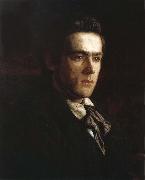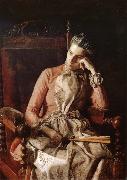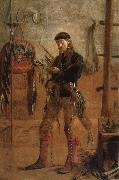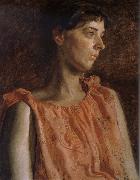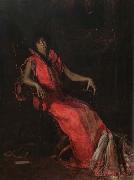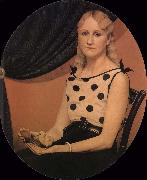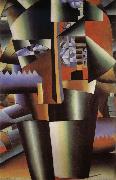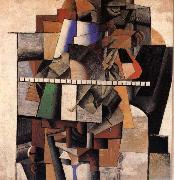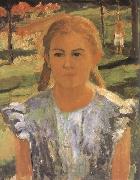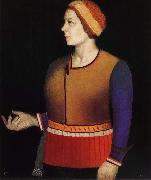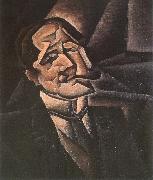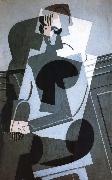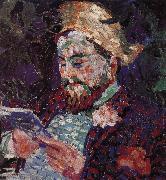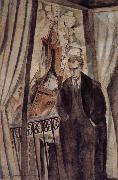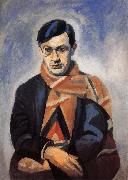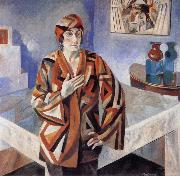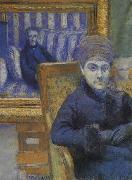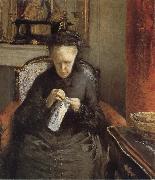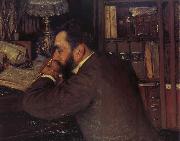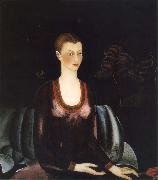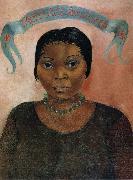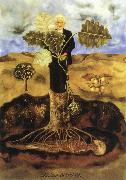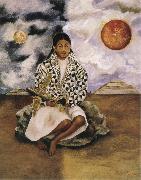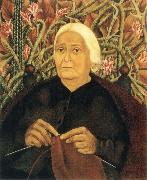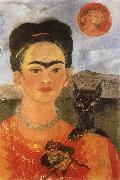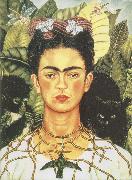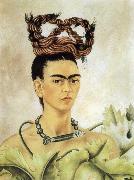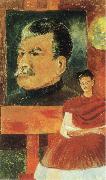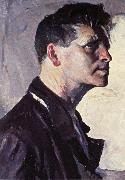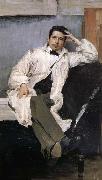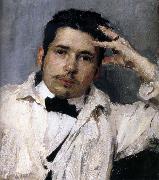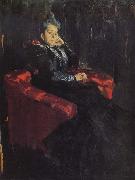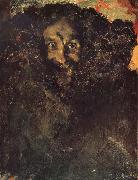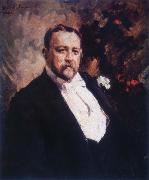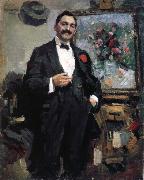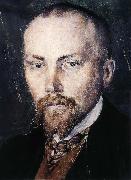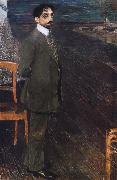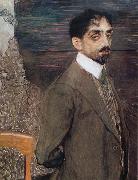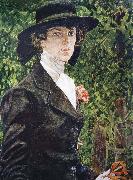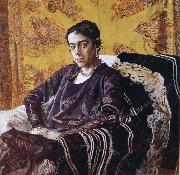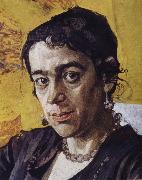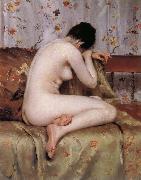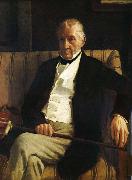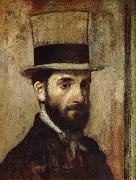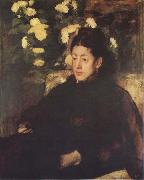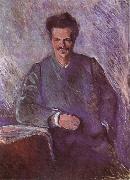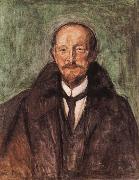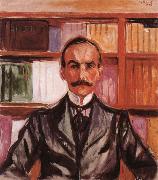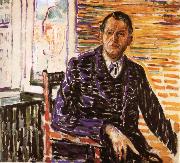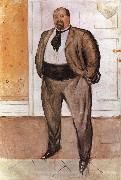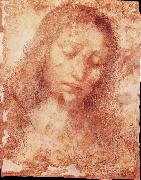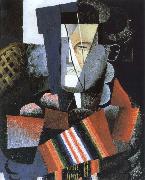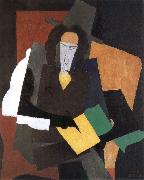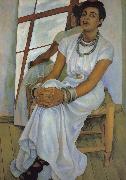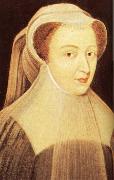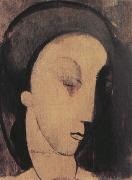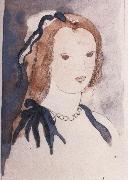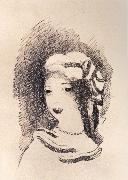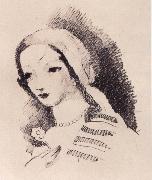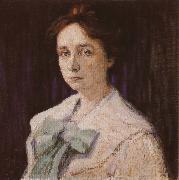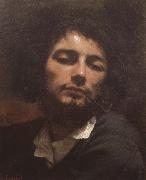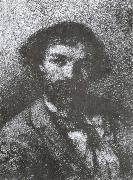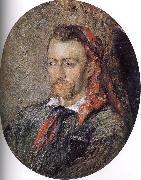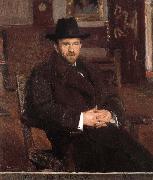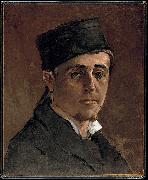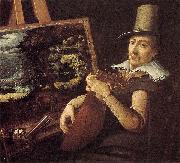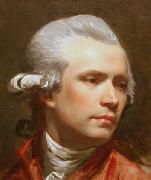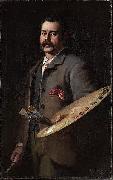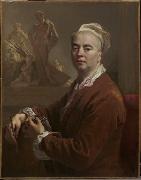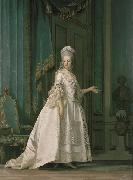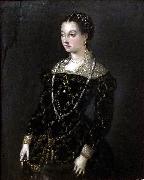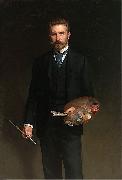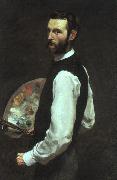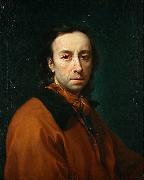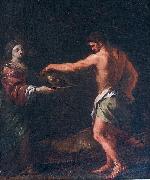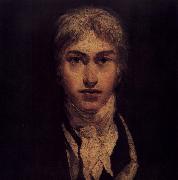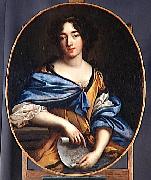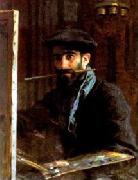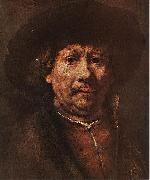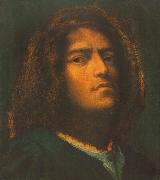Wholesale Oil Painting No Minimum |
|||||||||||
|
|
|||||||||||

|
|||||||||||
|
|
|
||||||||
Thomas EakinsAmerican Realist Painter, 1844-1916. Thomas Cowperthwait Eakins (July 25, 1844 ?C June 25, 1916) was a realist painter, photographer, sculptor, and fine arts educator. He is widely acknowledged to be one of the most important artists in American art history. For the length of his professional career, from the early 1870s until his health began to fail some forty years later, Eakins worked exactingly from life, choosing as his subject the people of his hometown of Philadelphia. He painted several hundred portraits, usually of friends, family members, or prominent people in the arts, sciences, medicine, and clergy. Taken en masse, the portraits offer an overview of the intellectual life of Philadelphia in the late 19th and early 20th centuries; individually, they are incisive depictions of thinking persons. As well, Eakins produced a number of large paintings which brought the portrait out of the drawing room and into the offices, streets, parks, rivers, arenas, and surgical amphitheaters of his city. These active outdoor venues allowed him to paint the subject which most inspired him: the nude or lightly clad figure in motion. In the process he could model the forms of the body in full sunlight, and create images of deep space utilizing his studies in perspective. No less important in Eakins' life was his work as a teacher. As an instructor he was a highly influential presence in American art. The difficulties which beset him as an artist seeking to paint the portrait and figure realistically were paralleled and even amplified in his career as an educator, where behavioral and sexual scandals truncated his success and damaged his reputation. Eakins also took a keen interest in the new technologies of motion photography, a field in which he is now seen as an innovator. Eakins was a controversial figure whose work received little by way of official recognition during his lifetime. Since his death, he has been celebrated by American art historians as "the strongest, most profound realist in nineteenth-and early-twentieth-century American art". |
||||||||
|
|
||||||||
Portrait
Portrait Painting ID:: 36083 |
mk108
189
watercolor
61x51cm
mk108 189 watercolor 61x51cm |
|||||||
|
|
||||||||
Thomas EakinsAmerican Realist Painter, 1844-1916. Thomas Cowperthwait Eakins (July 25, 1844 ?C June 25, 1916) was a realist painter, photographer, sculptor, and fine arts educator. He is widely acknowledged to be one of the most important artists in American art history. For the length of his professional career, from the early 1870s until his health began to fail some forty years later, Eakins worked exactingly from life, choosing as his subject the people of his hometown of Philadelphia. He painted several hundred portraits, usually of friends, family members, or prominent people in the arts, sciences, medicine, and clergy. Taken en masse, the portraits offer an overview of the intellectual life of Philadelphia in the late 19th and early 20th centuries; individually, they are incisive depictions of thinking persons. As well, Eakins produced a number of large paintings which brought the portrait out of the drawing room and into the offices, streets, parks, rivers, arenas, and surgical amphitheaters of his city. These active outdoor venues allowed him to paint the subject which most inspired him: the nude or lightly clad figure in motion. In the process he could model the forms of the body in full sunlight, and create images of deep space utilizing his studies in perspective. No less important in Eakins' life was his work as a teacher. As an instructor he was a highly influential presence in American art. The difficulties which beset him as an artist seeking to paint the portrait and figure realistically were paralleled and even amplified in his career as an educator, where behavioral and sexual scandals truncated his success and damaged his reputation. Eakins also took a keen interest in the new technologies of motion photography, a field in which he is now seen as an innovator. Eakins was a controversial figure whose work received little by way of official recognition during his lifetime. Since his death, he has been celebrated by American art historians as "the strongest, most profound realist in nineteenth-and early-twentieth-century American art". |
||||||||
|
|
||||||||
|
|
Portrait
Portrait Painting ID:: 36087 |
mk108
1891
Watercolor
114x81cm
mk108 1891 Watercolor 114x81cm |
||||||
|
|
||||||||
Thomas EakinsAmerican Realist Painter, 1844-1916. Thomas Cowperthwait Eakins (July 25, 1844 ?C June 25, 1916) was a realist painter, photographer, sculptor, and fine arts educator. He is widely acknowledged to be one of the most important artists in American art history. For the length of his professional career, from the early 1870s until his health began to fail some forty years later, Eakins worked exactingly from life, choosing as his subject the people of his hometown of Philadelphia. He painted several hundred portraits, usually of friends, family members, or prominent people in the arts, sciences, medicine, and clergy. Taken en masse, the portraits offer an overview of the intellectual life of Philadelphia in the late 19th and early 20th centuries; individually, they are incisive depictions of thinking persons. As well, Eakins produced a number of large paintings which brought the portrait out of the drawing room and into the offices, streets, parks, rivers, arenas, and surgical amphitheaters of his city. These active outdoor venues allowed him to paint the subject which most inspired him: the nude or lightly clad figure in motion. In the process he could model the forms of the body in full sunlight, and create images of deep space utilizing his studies in perspective. No less important in Eakins' life was his work as a teacher. As an instructor he was a highly influential presence in American art. The difficulties which beset him as an artist seeking to paint the portrait and figure realistically were paralleled and even amplified in his career as an educator, where behavioral and sexual scandals truncated his success and damaged his reputation. Eakins also took a keen interest in the new technologies of motion photography, a field in which he is now seen as an innovator. Eakins was a controversial figure whose work received little by way of official recognition during his lifetime. Since his death, he has been celebrated by American art historians as "the strongest, most profound realist in nineteenth-and early-twentieth-century American art". |
||||||||
|
|
||||||||
|
|
Portrait
Portrait Painting ID:: 36089 |
mk108
1895
Watercolor
228.5x152.5cm
mk108 1895 Watercolor 228.5x152.5cm |
||||||
|
|
||||||||
Thomas EakinsAmerican Realist Painter, 1844-1916. Thomas Cowperthwait Eakins (July 25, 1844 ?C June 25, 1916) was a realist painter, photographer, sculptor, and fine arts educator. He is widely acknowledged to be one of the most important artists in American art history. For the length of his professional career, from the early 1870s until his health began to fail some forty years later, Eakins worked exactingly from life, choosing as his subject the people of his hometown of Philadelphia. He painted several hundred portraits, usually of friends, family members, or prominent people in the arts, sciences, medicine, and clergy. Taken en masse, the portraits offer an overview of the intellectual life of Philadelphia in the late 19th and early 20th centuries; individually, they are incisive depictions of thinking persons. As well, Eakins produced a number of large paintings which brought the portrait out of the drawing room and into the offices, streets, parks, rivers, arenas, and surgical amphitheaters of his city. These active outdoor venues allowed him to paint the subject which most inspired him: the nude or lightly clad figure in motion. In the process he could model the forms of the body in full sunlight, and create images of deep space utilizing his studies in perspective. No less important in Eakins' life was his work as a teacher. As an instructor he was a highly influential presence in American art. The difficulties which beset him as an artist seeking to paint the portrait and figure realistically were paralleled and even amplified in his career as an educator, where behavioral and sexual scandals truncated his success and damaged his reputation. Eakins also took a keen interest in the new technologies of motion photography, a field in which he is now seen as an innovator. Eakins was a controversial figure whose work received little by way of official recognition during his lifetime. Since his death, he has been celebrated by American art historians as "the strongest, most profound realist in nineteenth-and early-twentieth-century American art". |
||||||||
|
|
||||||||
|
|
Portrait
Portrait Painting ID:: 36090 |
mk108
1891
Watercolor
61x50.8cm
mk108 1891 Watercolor 61x50.8cm |
||||||
|
|
||||||||
Thomas EakinsAmerican Realist Painter, 1844-1916. Thomas Cowperthwait Eakins (July 25, 1844 ?C June 25, 1916) was a realist painter, photographer, sculptor, and fine arts educator. He is widely acknowledged to be one of the most important artists in American art history. For the length of his professional career, from the early 1870s until his health began to fail some forty years later, Eakins worked exactingly from life, choosing as his subject the people of his hometown of Philadelphia. He painted several hundred portraits, usually of friends, family members, or prominent people in the arts, sciences, medicine, and clergy. Taken en masse, the portraits offer an overview of the intellectual life of Philadelphia in the late 19th and early 20th centuries; individually, they are incisive depictions of thinking persons. As well, Eakins produced a number of large paintings which brought the portrait out of the drawing room and into the offices, streets, parks, rivers, arenas, and surgical amphitheaters of his city. These active outdoor venues allowed him to paint the subject which most inspired him: the nude or lightly clad figure in motion. In the process he could model the forms of the body in full sunlight, and create images of deep space utilizing his studies in perspective. No less important in Eakins' life was his work as a teacher. As an instructor he was a highly influential presence in American art. The difficulties which beset him as an artist seeking to paint the portrait and figure realistically were paralleled and even amplified in his career as an educator, where behavioral and sexual scandals truncated his success and damaged his reputation. Eakins also took a keen interest in the new technologies of motion photography, a field in which he is now seen as an innovator. Eakins was a controversial figure whose work received little by way of official recognition during his lifetime. Since his death, he has been celebrated by American art historians as "the strongest, most profound realist in nineteenth-and early-twentieth-century American art". |
||||||||
|
|
||||||||
|
|
Portrait
Portrait Painting ID:: 36105 |
mk108
1903
Watercolor
168x104.5cm
mk108 1903 Watercolor 168x104.5cm |
||||||
|
|
||||||||
Thomas EakinsAmerican Realist Painter, 1844-1916. Thomas Cowperthwait Eakins (July 25, 1844 ?C June 25, 1916) was a realist painter, photographer, sculptor, and fine arts educator. He is widely acknowledged to be one of the most important artists in American art history. For the length of his professional career, from the early 1870s until his health began to fail some forty years later, Eakins worked exactingly from life, choosing as his subject the people of his hometown of Philadelphia. He painted several hundred portraits, usually of friends, family members, or prominent people in the arts, sciences, medicine, and clergy. Taken en masse, the portraits offer an overview of the intellectual life of Philadelphia in the late 19th and early 20th centuries; individually, they are incisive depictions of thinking persons. As well, Eakins produced a number of large paintings which brought the portrait out of the drawing room and into the offices, streets, parks, rivers, arenas, and surgical amphitheaters of his city. These active outdoor venues allowed him to paint the subject which most inspired him: the nude or lightly clad figure in motion. In the process he could model the forms of the body in full sunlight, and create images of deep space utilizing his studies in perspective. No less important in Eakins' life was his work as a teacher. As an instructor he was a highly influential presence in American art. The difficulties which beset him as an artist seeking to paint the portrait and figure realistically were paralleled and even amplified in his career as an educator, where behavioral and sexual scandals truncated his success and damaged his reputation. Eakins also took a keen interest in the new technologies of motion photography, a field in which he is now seen as an innovator. Eakins was a controversial figure whose work received little by way of official recognition during his lifetime. Since his death, he has been celebrated by American art historians as "the strongest, most profound realist in nineteenth-and early-twentieth-century American art". |
||||||||
|
|
||||||||
|
|
Portrait
Portrait Painting ID:: 36106 |
mk108
1903
Watercolor
202.5x152cm
mk108 1903 Watercolor 202.5x152cm |
||||||
|
|
||||||||
Grant Wood1891-1942 Grant Wood Locations His family moved to Cedar Rapids after his father died in 1901. Soon thereafter he began as an apprentice in a local metal shop. After graduating from Washington High School (Cedar Rapids, Iowa) , Wood enrolled in an art school in Minneapolis in 1910, and returned a year later to teach in a one-room schoolhouse. In 1913 he enrolled at the School of the Art Institute of Chicago and did some work as a silversmith. From 1920 to 1928 he made four trips to Europe, where he studied many styles of painting, especially impressionism and post-impressionism. But it was the work of Jan Van Eyck that influenced him to take on the clarity of this new technique and to incorporate it in his new works. From 1924 to 1935 Wood lived in the loft of a carriage house that he turned into his personal studio at "5 Turner Alley" (the studio had no address until Wood made one up himself). In 1932, Wood helped found the Stone City Art Colony near his hometown to help artists get through the Great Depression. He became a great proponent of regionalism in the arts, lecturing throughout the country on the topic. Wood taught painting at the University of Iowa's School of Art beginning in 1934. During that time, he supervised mural painting projects, mentored students, produced a variety of his own works, and became a key part of the University's cultural community. On February 12, 1942, one day before his 51st birthday, Wood died at the university hospital of liver cancer. When Wood died, his estate went to his sister, Nan Wood Graham, the woman portrayed in American Gothic. When she died in 1990, her estate, along with Wood's personal effects and various works of art, became the property of the Figge Art Museum in Davenport, Iowa. Wood was an active painter from an extremely young age until his death, and although he is best known for his paintings, he worked in a large number of media, including ink, charcoal, ceramics, metal, wood and found objects. Throughout his life he hired out his talents to many Iowa-based businesses as a steady source of income. This included painting advertisements, sketching rooms of a mortuary house for promotional flyers and, in one case, designing the corn-themed decor (including chandelier) for the dining room of a hotel. In addition, his 1928 trip to Munich was to oversee the making of the stained-glass windows he had designed for a Veterans Memorial Building in Cedar Rapids. He again returned to Cedar Rapids to teach Junior High students after serving in the army as a camouflage painter. |
||||||||
|
|
||||||||
|
|
Portrait
Portrait Painting ID:: 36178 |
mk109
1933
87.5x72cm
mk109 1933 87.5x72cm |
||||||
|
|
||||||||
Kasimir Malevich1878-1935 Kasimir Malevich Gallery In 1904, after the death of his father, he moved to Moscow. He studied at the Moscow School of Painting, Sculpture and Architecture from 1904 to 1910 and in the studio of Fedor Rerberg in Moscow (1904?C1910). In 1911 he participated in the second exhibition of the group Soyuz Molodyozhi (Union of Youth) in St. Petersburg, together with Vladimir Tatlin and, in 1912, the group held its third exhibition, which included works by Aleksandra Ekster, Tatlin and others. In the same year he participated in an exhibition by the collective Donkey's Tail in Moscow. By that time his works were influenced by Natalia Goncharova and Mikhail Larionov, Russian avant-garde painters who were particularly interested in Russian folk art called lubok. In March 1913 a major exhibition of Aristarkh Lentulov's paintings opened in Moscow. The effect of this exhibition was comparable with that of Paul Cezanne in Paris in 1907, as all the main Russian avant-garde artists of the time (including Malevich) immediately absorbed the cubist principles and began using them in their works. Already in the same year the Cubo-Futurist opera Victory Over the Sun with Malevich's stage-set became a great success. In 1914 Malevich exhibited his works in the Salon des Independants in Paris together with Alexander Archipenko, Sonia Delaunay, Aleksandra Ekster and Vadim Meller, among others. It remains one of the great mysteries of 20th century art, how, while leading a comfortable career, during which he just followed all the latest trends in art, in 1915 Malevich suddenly came up with the idea of Suprematism. The fact that Malevich throughout all his life was signing and re-signing his works using earlier dates makes this u-turn in his artistic career even more ambiguous. Be that as it may, in 1915 he published his manifesto From Cubism to Suprematism. In 1915-1916 he worked with other Suprematist artists in a peasant/artisan co-operative in Skoptsi and Verbovka village. In 1916-1917 he participated in exhibitions of the Jack of Diamonds group in Moscow together with Nathan Altman, David Burliuk and A. Ekster, among others. Famous examples of his Suprematist works include Black Square (1915) and White on White (1918). In 1918 Malevich decorated a play Mystery Bouffe by Vladimir Mayakovskiy produced by Vsevolod Meyerhold. Malevich also acknowledged that his fascination with aerial photography and aviation led him to abstractions inspired by or derived from aerial landscapes. Harvard doctoral candidate Julia Bekman Chadaga writes: ??In his later writings, Malevich defined the 'additional element' as the quality of any new visual environment bringing about a change in perception .... In a series of diagrams illustrating the ??environments' that influence various painterly styles, the Suprematist is associated with a series of aerial views rendering the familiar landscape into an abstraction..." (excerpted from Ms. Bekman Chadaga's paper delivered at Columbia University's 2000 symposium, "Art, Technology, and Modernity in Russia and Eastern Europe"). |
||||||||
|
|
||||||||
|
|
Portrait
Portrait Painting ID:: 36242 |
mk110
1913
112x70cm
mk110 1913 112x70cm |
||||||
|
|
||||||||
Kasimir Malevich1878-1935 Kasimir Malevich Gallery In 1904, after the death of his father, he moved to Moscow. He studied at the Moscow School of Painting, Sculpture and Architecture from 1904 to 1910 and in the studio of Fedor Rerberg in Moscow (1904?C1910). In 1911 he participated in the second exhibition of the group Soyuz Molodyozhi (Union of Youth) in St. Petersburg, together with Vladimir Tatlin and, in 1912, the group held its third exhibition, which included works by Aleksandra Ekster, Tatlin and others. In the same year he participated in an exhibition by the collective Donkey's Tail in Moscow. By that time his works were influenced by Natalia Goncharova and Mikhail Larionov, Russian avant-garde painters who were particularly interested in Russian folk art called lubok. In March 1913 a major exhibition of Aristarkh Lentulov's paintings opened in Moscow. The effect of this exhibition was comparable with that of Paul Cezanne in Paris in 1907, as all the main Russian avant-garde artists of the time (including Malevich) immediately absorbed the cubist principles and began using them in their works. Already in the same year the Cubo-Futurist opera Victory Over the Sun with Malevich's stage-set became a great success. In 1914 Malevich exhibited his works in the Salon des Independants in Paris together with Alexander Archipenko, Sonia Delaunay, Aleksandra Ekster and Vadim Meller, among others. It remains one of the great mysteries of 20th century art, how, while leading a comfortable career, during which he just followed all the latest trends in art, in 1915 Malevich suddenly came up with the idea of Suprematism. The fact that Malevich throughout all his life was signing and re-signing his works using earlier dates makes this u-turn in his artistic career even more ambiguous. Be that as it may, in 1915 he published his manifesto From Cubism to Suprematism. In 1915-1916 he worked with other Suprematist artists in a peasant/artisan co-operative in Skoptsi and Verbovka village. In 1916-1917 he participated in exhibitions of the Jack of Diamonds group in Moscow together with Nathan Altman, David Burliuk and A. Ekster, among others. Famous examples of his Suprematist works include Black Square (1915) and White on White (1918). In 1918 Malevich decorated a play Mystery Bouffe by Vladimir Mayakovskiy produced by Vsevolod Meyerhold. Malevich also acknowledged that his fascination with aerial photography and aviation led him to abstractions inspired by or derived from aerial landscapes. Harvard doctoral candidate Julia Bekman Chadaga writes: ??In his later writings, Malevich defined the 'additional element' as the quality of any new visual environment bringing about a change in perception .... In a series of diagrams illustrating the ??environments' that influence various painterly styles, the Suprematist is associated with a series of aerial views rendering the familiar landscape into an abstraction..." (excerpted from Ms. Bekman Chadaga's paper delivered at Columbia University's 2000 symposium, "Art, Technology, and Modernity in Russia and Eastern Europe"). |
||||||||
|
|
||||||||
|
|
Portrait
Portrait Painting ID:: 36244 |
mk110
1913
Oil on canvas
106.3x106.3cm
mk110 1913 Oil on canvas 106.3x106.3cm |
||||||
|
|
||||||||
Kasimir Malevich1878-1935 Kasimir Malevich Gallery In 1904, after the death of his father, he moved to Moscow. He studied at the Moscow School of Painting, Sculpture and Architecture from 1904 to 1910 and in the studio of Fedor Rerberg in Moscow (1904?C1910). In 1911 he participated in the second exhibition of the group Soyuz Molodyozhi (Union of Youth) in St. Petersburg, together with Vladimir Tatlin and, in 1912, the group held its third exhibition, which included works by Aleksandra Ekster, Tatlin and others. In the same year he participated in an exhibition by the collective Donkey's Tail in Moscow. By that time his works were influenced by Natalia Goncharova and Mikhail Larionov, Russian avant-garde painters who were particularly interested in Russian folk art called lubok. In March 1913 a major exhibition of Aristarkh Lentulov's paintings opened in Moscow. The effect of this exhibition was comparable with that of Paul Cezanne in Paris in 1907, as all the main Russian avant-garde artists of the time (including Malevich) immediately absorbed the cubist principles and began using them in their works. Already in the same year the Cubo-Futurist opera Victory Over the Sun with Malevich's stage-set became a great success. In 1914 Malevich exhibited his works in the Salon des Independants in Paris together with Alexander Archipenko, Sonia Delaunay, Aleksandra Ekster and Vadim Meller, among others. It remains one of the great mysteries of 20th century art, how, while leading a comfortable career, during which he just followed all the latest trends in art, in 1915 Malevich suddenly came up with the idea of Suprematism. The fact that Malevich throughout all his life was signing and re-signing his works using earlier dates makes this u-turn in his artistic career even more ambiguous. Be that as it may, in 1915 he published his manifesto From Cubism to Suprematism. In 1915-1916 he worked with other Suprematist artists in a peasant/artisan co-operative in Skoptsi and Verbovka village. In 1916-1917 he participated in exhibitions of the Jack of Diamonds group in Moscow together with Nathan Altman, David Burliuk and A. Ekster, among others. Famous examples of his Suprematist works include Black Square (1915) and White on White (1918). In 1918 Malevich decorated a play Mystery Bouffe by Vladimir Mayakovskiy produced by Vsevolod Meyerhold. Malevich also acknowledged that his fascination with aerial photography and aviation led him to abstractions inspired by or derived from aerial landscapes. Harvard doctoral candidate Julia Bekman Chadaga writes: ??In his later writings, Malevich defined the 'additional element' as the quality of any new visual environment bringing about a change in perception .... In a series of diagrams illustrating the ??environments' that influence various painterly styles, the Suprematist is associated with a series of aerial views rendering the familiar landscape into an abstraction..." (excerpted from Ms. Bekman Chadaga's paper delivered at Columbia University's 2000 symposium, "Art, Technology, and Modernity in Russia and Eastern Europe"). |
||||||||
|
|
||||||||
|
|
Portrait
Portrait Painting ID:: 36297 |
mk10
1932
mk10 1932 |
||||||
|
|
||||||||
Kasimir Malevich1878-1935 Kasimir Malevich Gallery In 1904, after the death of his father, he moved to Moscow. He studied at the Moscow School of Painting, Sculpture and Architecture from 1904 to 1910 and in the studio of Fedor Rerberg in Moscow (1904?C1910). In 1911 he participated in the second exhibition of the group Soyuz Molodyozhi (Union of Youth) in St. Petersburg, together with Vladimir Tatlin and, in 1912, the group held its third exhibition, which included works by Aleksandra Ekster, Tatlin and others. In the same year he participated in an exhibition by the collective Donkey's Tail in Moscow. By that time his works were influenced by Natalia Goncharova and Mikhail Larionov, Russian avant-garde painters who were particularly interested in Russian folk art called lubok. In March 1913 a major exhibition of Aristarkh Lentulov's paintings opened in Moscow. The effect of this exhibition was comparable with that of Paul Cezanne in Paris in 1907, as all the main Russian avant-garde artists of the time (including Malevich) immediately absorbed the cubist principles and began using them in their works. Already in the same year the Cubo-Futurist opera Victory Over the Sun with Malevich's stage-set became a great success. In 1914 Malevich exhibited his works in the Salon des Independants in Paris together with Alexander Archipenko, Sonia Delaunay, Aleksandra Ekster and Vadim Meller, among others. It remains one of the great mysteries of 20th century art, how, while leading a comfortable career, during which he just followed all the latest trends in art, in 1915 Malevich suddenly came up with the idea of Suprematism. The fact that Malevich throughout all his life was signing and re-signing his works using earlier dates makes this u-turn in his artistic career even more ambiguous. Be that as it may, in 1915 he published his manifesto From Cubism to Suprematism. In 1915-1916 he worked with other Suprematist artists in a peasant/artisan co-operative in Skoptsi and Verbovka village. In 1916-1917 he participated in exhibitions of the Jack of Diamonds group in Moscow together with Nathan Altman, David Burliuk and A. Ekster, among others. Famous examples of his Suprematist works include Black Square (1915) and White on White (1918). In 1918 Malevich decorated a play Mystery Bouffe by Vladimir Mayakovskiy produced by Vsevolod Meyerhold. Malevich also acknowledged that his fascination with aerial photography and aviation led him to abstractions inspired by or derived from aerial landscapes. Harvard doctoral candidate Julia Bekman Chadaga writes: ??In his later writings, Malevich defined the 'additional element' as the quality of any new visual environment bringing about a change in perception .... In a series of diagrams illustrating the ??environments' that influence various painterly styles, the Suprematist is associated with a series of aerial views rendering the familiar landscape into an abstraction..." (excerpted from Ms. Bekman Chadaga's paper delivered at Columbia University's 2000 symposium, "Art, Technology, and Modernity in Russia and Eastern Europe"). |
||||||||
|
|
||||||||
|
|
Portrait
Portrait Painting ID:: 36299 |
mk110
1933
Oil on canvas
67.5x56cm mk110 1933 Oil on canvas 67.5x56cm |
||||||
|
|
||||||||
Kasimir Malevich1878-1935 Kasimir Malevich Gallery In 1904, after the death of his father, he moved to Moscow. He studied at the Moscow School of Painting, Sculpture and Architecture from 1904 to 1910 and in the studio of Fedor Rerberg in Moscow (1904?C1910). In 1911 he participated in the second exhibition of the group Soyuz Molodyozhi (Union of Youth) in St. Petersburg, together with Vladimir Tatlin and, in 1912, the group held its third exhibition, which included works by Aleksandra Ekster, Tatlin and others. In the same year he participated in an exhibition by the collective Donkey's Tail in Moscow. By that time his works were influenced by Natalia Goncharova and Mikhail Larionov, Russian avant-garde painters who were particularly interested in Russian folk art called lubok. In March 1913 a major exhibition of Aristarkh Lentulov's paintings opened in Moscow. The effect of this exhibition was comparable with that of Paul Cezanne in Paris in 1907, as all the main Russian avant-garde artists of the time (including Malevich) immediately absorbed the cubist principles and began using them in their works. Already in the same year the Cubo-Futurist opera Victory Over the Sun with Malevich's stage-set became a great success. In 1914 Malevich exhibited his works in the Salon des Independants in Paris together with Alexander Archipenko, Sonia Delaunay, Aleksandra Ekster and Vadim Meller, among others. It remains one of the great mysteries of 20th century art, how, while leading a comfortable career, during which he just followed all the latest trends in art, in 1915 Malevich suddenly came up with the idea of Suprematism. The fact that Malevich throughout all his life was signing and re-signing his works using earlier dates makes this u-turn in his artistic career even more ambiguous. Be that as it may, in 1915 he published his manifesto From Cubism to Suprematism. In 1915-1916 he worked with other Suprematist artists in a peasant/artisan co-operative in Skoptsi and Verbovka village. In 1916-1917 he participated in exhibitions of the Jack of Diamonds group in Moscow together with Nathan Altman, David Burliuk and A. Ekster, among others. Famous examples of his Suprematist works include Black Square (1915) and White on White (1918). In 1918 Malevich decorated a play Mystery Bouffe by Vladimir Mayakovskiy produced by Vsevolod Meyerhold. Malevich also acknowledged that his fascination with aerial photography and aviation led him to abstractions inspired by or derived from aerial landscapes. Harvard doctoral candidate Julia Bekman Chadaga writes: ??In his later writings, Malevich defined the 'additional element' as the quality of any new visual environment bringing about a change in perception .... In a series of diagrams illustrating the ??environments' that influence various painterly styles, the Suprematist is associated with a series of aerial views rendering the familiar landscape into an abstraction..." (excerpted from Ms. Bekman Chadaga's paper delivered at Columbia University's 2000 symposium, "Art, Technology, and Modernity in Russia and Eastern Europe"). |
||||||||
|
|
||||||||
|
|
Portrait
Portrait Painting ID:: 36311 |
mk110
1933
Oil on canvas
70x57.5cm
mk110 1933 Oil on canvas 70x57.5cm |
||||||
|
|
||||||||
Juan Gris1887-1927 Born in Madrid, he studied mechanical drawing at the Escuela de Artes y Manufacturas in Madrid from 1902 to 1904, during which time he contributed drawings to local periodicals. From 1904 to 1905 he studied painting with the academic artist Jose Maria Carbonero. In 1906 he moved to Paris and became friends with Henri Matisse, Georges Braque, Fernand Leger, and in 1915 he was painted by his friend, Amedeo Modigliani. In Paris, Gris followed the lead of another friend and fellow countryman, Pablo Picasso. His portrait of Picasso in 1912 is a significant early Cubist painting done by a painter other than Picasso or Georges Braque. (Although he regarded Picasso as a teacher, Gertrude Stein acknowledged that Gris "was the one person that Picasso would have willingly wiped off the map.") Portrait of Picasso, 1912, The Art Institute of Chicago.Although he submitted darkly humorous illustrations to journals such as Le Rire, L'assiette au beurre, Le Charivari, and Le Cri de Paris, Gris began to paint seriously in 1910. By 1912 he had developed a personal Cubist style. At first Gris painted in the analytic style of Cubism, but after 1913 he began his conversion to synthetic Cubism, of which he became a steadfast interpreter, with extensive use of papier coll??. Unlike Picasso and Braque, whose Cubist works were monochromatic, Gris painted with bright harmonious colors in daring, novel combinations in the manner of his friend Matisse. In 1924, he first designed ballet sets and costumes for Sergei Diaghilev and the famous Ballets Russes. Gris articulated most of his aesthetic theories during 1924 and 1925. He delivered his definitive lecture, Des possibilit??s de la peinture, at the Sorbonne in 1924. Major Gris exhibitions took place at the Galerie Simon in Paris and the Galerie Flechtheim in Berlin in 1923, and at the Galerie Flechtheim in D??sseldorf in 1925. He died in Boulogne-sur-Seine (Paris) in the spring of 1927 at the age of forty, leaving a wife, Josette, and a son, Georges. |
||||||||
|
|
||||||||
|
|
Portrait
Portrait Painting ID:: 36499 |
mk112
1911
Oil on canvas
53x46cm mk112 1911 Oil on canvas 53x46cm |
||||||
|
|
||||||||
Juan Gris1887-1927 Born in Madrid, he studied mechanical drawing at the Escuela de Artes y Manufacturas in Madrid from 1902 to 1904, during which time he contributed drawings to local periodicals. From 1904 to 1905 he studied painting with the academic artist Jose Maria Carbonero. In 1906 he moved to Paris and became friends with Henri Matisse, Georges Braque, Fernand Leger, and in 1915 he was painted by his friend, Amedeo Modigliani. In Paris, Gris followed the lead of another friend and fellow countryman, Pablo Picasso. His portrait of Picasso in 1912 is a significant early Cubist painting done by a painter other than Picasso or Georges Braque. (Although he regarded Picasso as a teacher, Gertrude Stein acknowledged that Gris "was the one person that Picasso would have willingly wiped off the map.") Portrait of Picasso, 1912, The Art Institute of Chicago.Although he submitted darkly humorous illustrations to journals such as Le Rire, L'assiette au beurre, Le Charivari, and Le Cri de Paris, Gris began to paint seriously in 1910. By 1912 he had developed a personal Cubist style. At first Gris painted in the analytic style of Cubism, but after 1913 he began his conversion to synthetic Cubism, of which he became a steadfast interpreter, with extensive use of papier coll??. Unlike Picasso and Braque, whose Cubist works were monochromatic, Gris painted with bright harmonious colors in daring, novel combinations in the manner of his friend Matisse. In 1924, he first designed ballet sets and costumes for Sergei Diaghilev and the famous Ballets Russes. Gris articulated most of his aesthetic theories during 1924 and 1925. He delivered his definitive lecture, Des possibilit??s de la peinture, at the Sorbonne in 1924. Major Gris exhibitions took place at the Galerie Simon in Paris and the Galerie Flechtheim in Berlin in 1923, and at the Galerie Flechtheim in D??sseldorf in 1925. He died in Boulogne-sur-Seine (Paris) in the spring of 1927 at the age of forty, leaving a wife, Josette, and a son, Georges. |
||||||||
|
|
||||||||
|
|
Portrait
Portrait Painting ID:: 36555 |
mk112
1916
Oil on canvas
116x73cm
mk112 1916 Oil on canvas 116x73cm |
||||||
|
|
||||||||
Delaunay, RobertFrench Cubist Painter, 1885-1941 French painter, printmaker and writer. Taking Cubism as one of his points of departure, he first developed a vocabulary of colour planes only distantly dependent on observed motifs, and by the 1930s he had arrived at a purely self-sufficient language of geometric forms. He remained active as a theoretician until the end of his life, |
||||||||
|
|
||||||||
|
|
Portrait
Portrait Painting ID:: 36638 |
mk113
1906
Oil on canvas
64x60cm
mk113 1906 Oil on canvas 64x60cm |
||||||
|
|
||||||||
Delaunay, RobertFrench Cubist Painter, 1885-1941 French painter, printmaker and writer. Taking Cubism as one of his points of departure, he first developed a vocabulary of colour planes only distantly dependent on observed motifs, and by the 1930s he had arrived at a purely self-sufficient language of geometric forms. He remained active as a theoretician until the end of his life, |
||||||||
|
|
||||||||
|
|
Portrait
Portrait Painting ID:: 36721 |
mk113
1922
195x130cm
mk113 1922 195x130cm |
||||||
|
|
||||||||
Delaunay, RobertFrench Cubist Painter, 1885-1941 French painter, printmaker and writer. Taking Cubism as one of his points of departure, he first developed a vocabulary of colour planes only distantly dependent on observed motifs, and by the 1930s he had arrived at a purely self-sufficient language of geometric forms. He remained active as a theoretician until the end of his life, |
||||||||
|
|
||||||||
|
|
Portrait
Portrait Painting ID:: 36723 |
mk113
1923
105.3x75cm
mk113 1923 105.3x75cm |
||||||
|
|
||||||||
Delaunay, RobertFrench Cubist Painter, 1885-1941 French painter, printmaker and writer. Taking Cubism as one of his points of departure, he first developed a vocabulary of colour planes only distantly dependent on observed motifs, and by the 1930s he had arrived at a purely self-sufficient language of geometric forms. He remained active as a theoretician until the end of his life, |
||||||||
|
|
||||||||
|
|
Portrait
Portrait Painting ID:: 36724 |
mk113
1923
Oil on canvas
123.5x124cm
mk113 1923 Oil on canvas 123.5x124cm |
||||||
|
|
||||||||
Gustave CaillebotteFrench Impressionist Painter, 1848-1894 Gustave Caillebotte was born on August 19, 1848 to an upper-class Parisian family. His father, Martial Caillebotte (1799-1874), was the inheritor of the family textile industry and was also a judge at the Seine Tribunal de Commerce. Caillebotte father had been twice widowed before marrying Caillebotte mother, C??leste Daufresne (1819-1878), who had two more sons after Gustave, Rene (1851-1876) and Martial (1853-1910). |
||||||||
|
|
||||||||
|
|
Portrait
Portrait Painting ID:: 37054 |
mk11
1878
Oil on canvas
204x92cm
mk11 1878 Oil on canvas 204x92cm |
||||||
|
|
||||||||
Gustave CaillebotteFrench Impressionist Painter, 1848-1894 Gustave Caillebotte was born on August 19, 1848 to an upper-class Parisian family. His father, Martial Caillebotte (1799-1874), was the inheritor of the family textile industry and was also a judge at the Seine Tribunal de Commerce. Caillebotte father had been twice widowed before marrying Caillebotte mother, C??leste Daufresne (1819-1878), who had two more sons after Gustave, Rene (1851-1876) and Martial (1853-1910). |
||||||||
|
|
||||||||
|
|
Portrait
Portrait Painting ID:: 37055 |
mk116
1878
Oil on canvas
65x50cm
mk116 1878 Oil on canvas 65x50cm |
||||||
|
|
||||||||
Gustave CaillebotteFrench Impressionist Painter, 1848-1894 Gustave Caillebotte was born on August 19, 1848 to an upper-class Parisian family. His father, Martial Caillebotte (1799-1874), was the inheritor of the family textile industry and was also a judge at the Seine Tribunal de Commerce. Caillebotte father had been twice widowed before marrying Caillebotte mother, C??leste Daufresne (1819-1878), who had two more sons after Gustave, Rene (1851-1876) and Martial (1853-1910). |
||||||||
|
|
||||||||
|
|
Portrait
Portrait Painting ID:: 37061 |
mk116
1877
Oil on canvas
83x72cm
mk116 1877 Oil on canvas 83x72cm |
||||||
|
|
||||||||
Gustave CaillebotteFrench Impressionist Painter, 1848-1894 Gustave Caillebotte was born on August 19, 1848 to an upper-class Parisian family. His father, Martial Caillebotte (1799-1874), was the inheritor of the family textile industry and was also a judge at the Seine Tribunal de Commerce. Caillebotte father had been twice widowed before marrying Caillebotte mother, C??leste Daufresne (1819-1878), who had two more sons after Gustave, Rene (1851-1876) and Martial (1853-1910). |
||||||||
|
|
||||||||
|
|
Portrait
Portrait Painting ID:: 37071 |
mk116
1883
Oil on canvas
63x81.3cm
mk116 1883 Oil on canvas 63x81.3cm |
||||||
|
|
||||||||
Frida Kahlo1907-54 Mexican painter, b. Coyoacen. As a result of an accident at age 15, Kahlo turned her attention from a medical career to painting. Drawing on her personal experiences, her works are often shocking in their stark portrayal of pain and the harsh lives of women. Fifty-five of her 143 paintings are self-portraits incorporating a personal symbolism complete with graphic anatomical references. She was also influenced by indigenous Mexican culture, aspects of which she portrayed in bright colors, with a mixture of realism and symbolism. Her paintings attracted the attention of the artist Diego Rivera, whom she later married. Although Kahlo's work is sometimes classified as surrealist and she did exhibit several times with European surrealists, she herself disputed the label. Her preoccupation with female themes and the figurative candor with which she expressed them made her something of a feminist cult figure in the last decades of the 20th cent. |
||||||||
|
|
||||||||
|
|
Portrait
Portrait Painting ID:: 37100 |
mk118
1927
Oil on canvas
107x93.5cm
mk118 1927 Oil on canvas 107x93.5cm |
||||||
|
|
||||||||
Frida Kahlo1907-54 Mexican painter, b. Coyoacen. As a result of an accident at age 15, Kahlo turned her attention from a medical career to painting. Drawing on her personal experiences, her works are often shocking in their stark portrayal of pain and the harsh lives of women. Fifty-five of her 143 paintings are self-portraits incorporating a personal symbolism complete with graphic anatomical references. She was also influenced by indigenous Mexican culture, aspects of which she portrayed in bright colors, with a mixture of realism and symbolism. Her paintings attracted the attention of the artist Diego Rivera, whom she later married. Although Kahlo's work is sometimes classified as surrealist and she did exhibit several times with European surrealists, she herself disputed the label. Her preoccupation with female themes and the figurative candor with which she expressed them made her something of a feminist cult figure in the last decades of the 20th cent. |
||||||||
|
|
||||||||
|
|
Portrait
Portrait Painting ID:: 37109 |
mk118
1931
Oil on canvas
63x46cm
mk118 1931 Oil on canvas 63x46cm |
||||||
|
|
||||||||
Frida Kahlo1907-54 Mexican painter, b. Coyoacen. As a result of an accident at age 15, Kahlo turned her attention from a medical career to painting. Drawing on her personal experiences, her works are often shocking in their stark portrayal of pain and the harsh lives of women. Fifty-five of her 143 paintings are self-portraits incorporating a personal symbolism complete with graphic anatomical references. She was also influenced by indigenous Mexican culture, aspects of which she portrayed in bright colors, with a mixture of realism and symbolism. Her paintings attracted the attention of the artist Diego Rivera, whom she later married. Although Kahlo's work is sometimes classified as surrealist and she did exhibit several times with European surrealists, she herself disputed the label. Her preoccupation with female themes and the figurative candor with which she expressed them made her something of a feminist cult figure in the last decades of the 20th cent. |
||||||||
|
|
||||||||
|
|
Portrait
Portrait Painting ID:: 37111 |
mk118
1931
Oil on canvas
86.5x61.7cm
mk118 1931 Oil on canvas 86.5x61.7cm |
||||||
|
|
||||||||
Frida Kahlo1907-54 Mexican painter, b. Coyoacen. As a result of an accident at age 15, Kahlo turned her attention from a medical career to painting. Drawing on her personal experiences, her works are often shocking in their stark portrayal of pain and the harsh lives of women. Fifty-five of her 143 paintings are self-portraits incorporating a personal symbolism complete with graphic anatomical references. She was also influenced by indigenous Mexican culture, aspects of which she portrayed in bright colors, with a mixture of realism and symbolism. Her paintings attracted the attention of the artist Diego Rivera, whom she later married. Although Kahlo's work is sometimes classified as surrealist and she did exhibit several times with European surrealists, she herself disputed the label. Her preoccupation with female themes and the figurative candor with which she expressed them made her something of a feminist cult figure in the last decades of the 20th cent. |
||||||||
|
|
||||||||
|
|
Portrait
Portrait Painting ID:: 37139 |
mk118
1942
mk118 1942 |
||||||
|
|
||||||||
Frida Kahlo1907-54 Mexican painter, b. Coyoacen. As a result of an accident at age 15, Kahlo turned her attention from a medical career to painting. Drawing on her personal experiences, her works are often shocking in their stark portrayal of pain and the harsh lives of women. Fifty-five of her 143 paintings are self-portraits incorporating a personal symbolism complete with graphic anatomical references. She was also influenced by indigenous Mexican culture, aspects of which she portrayed in bright colors, with a mixture of realism and symbolism. Her paintings attracted the attention of the artist Diego Rivera, whom she later married. Although Kahlo's work is sometimes classified as surrealist and she did exhibit several times with European surrealists, she herself disputed the label. Her preoccupation with female themes and the figurative candor with which she expressed them made her something of a feminist cult figure in the last decades of the 20th cent. |
||||||||
|
|
||||||||
|
|
Portrait
Portrait Painting ID:: 37146 |
mk118
1944
Oil on canvas
76x60.5cm
mk118 1944 Oil on canvas 76x60.5cm |
||||||
|
|
||||||||
Frida Kahlo1907-54 Mexican painter, b. Coyoacen. As a result of an accident at age 15, Kahlo turned her attention from a medical career to painting. Drawing on her personal experiences, her works are often shocking in their stark portrayal of pain and the harsh lives of women. Fifty-five of her 143 paintings are self-portraits incorporating a personal symbolism complete with graphic anatomical references. She was also influenced by indigenous Mexican culture, aspects of which she portrayed in bright colors, with a mixture of realism and symbolism. Her paintings attracted the attention of the artist Diego Rivera, whom she later married. Although Kahlo's work is sometimes classified as surrealist and she did exhibit several times with European surrealists, she herself disputed the label. Her preoccupation with female themes and the figurative candor with which she expressed them made her something of a feminist cult figure in the last decades of the 20th cent. |
||||||||
|
|
||||||||
|
|
Portrait
Portrait Painting ID:: 37164 |
mk118
1953-1954
Oil on canvas
61x41cm
mk118 1953-1954 Oil on canvas 61x41cm |
||||||
|
|
||||||||
Frida Kahlo1907-54 Mexican painter, b. Coyoacen. As a result of an accident at age 15, Kahlo turned her attention from a medical career to painting. Drawing on her personal experiences, her works are often shocking in their stark portrayal of pain and the harsh lives of women. Fifty-five of her 143 paintings are self-portraits incorporating a personal symbolism complete with graphic anatomical references. She was also influenced by indigenous Mexican culture, aspects of which she portrayed in bright colors, with a mixture of realism and symbolism. Her paintings attracted the attention of the artist Diego Rivera, whom she later married. Although Kahlo's work is sometimes classified as surrealist and she did exhibit several times with European surrealists, she herself disputed the label. Her preoccupation with female themes and the figurative candor with which she expressed them made her something of a feminist cult figure in the last decades of the 20th cent. |
||||||||
|
|
||||||||
|
|
Portrait
Portrait Painting ID:: 37171 |
mk118
1940
Oil on canvas
62.2x47.6cm
mk118 1940 Oil on canvas 62.2x47.6cm |
||||||
|
|
||||||||
Frida Kahlo1907-54 Mexican painter, b. Coyoacen. As a result of an accident at age 15, Kahlo turned her attention from a medical career to painting. Drawing on her personal experiences, her works are often shocking in their stark portrayal of pain and the harsh lives of women. Fifty-five of her 143 paintings are self-portraits incorporating a personal symbolism complete with graphic anatomical references. She was also influenced by indigenous Mexican culture, aspects of which she portrayed in bright colors, with a mixture of realism and symbolism. Her paintings attracted the attention of the artist Diego Rivera, whom she later married. Although Kahlo's work is sometimes classified as surrealist and she did exhibit several times with European surrealists, she herself disputed the label. Her preoccupation with female themes and the figurative candor with which she expressed them made her something of a feminist cult figure in the last decades of the 20th cent. |
||||||||
|
|
||||||||
|
|
Portrait
Portrait Painting ID:: 37174 |
mk118
1941
Oil on canvas
51x38.5cm
mk118 1941 Oil on canvas 51x38.5cm |
||||||
|
|
||||||||
Frida Kahlo1907-54 Mexican painter, b. Coyoacen. As a result of an accident at age 15, Kahlo turned her attention from a medical career to painting. Drawing on her personal experiences, her works are often shocking in their stark portrayal of pain and the harsh lives of women. Fifty-five of her 143 paintings are self-portraits incorporating a personal symbolism complete with graphic anatomical references. She was also influenced by indigenous Mexican culture, aspects of which she portrayed in bright colors, with a mixture of realism and symbolism. Her paintings attracted the attention of the artist Diego Rivera, whom she later married. Although Kahlo's work is sometimes classified as surrealist and she did exhibit several times with European surrealists, she herself disputed the label. Her preoccupation with female themes and the figurative candor with which she expressed them made her something of a feminist cult figure in the last decades of the 20th cent. |
||||||||
|
|
||||||||
|
|
Portrait
Portrait Painting ID:: 37183 |
mk118
1954
Oil on canvas
59x39cm
mk118 1954 Oil on canvas 59x39cm |
||||||
|
|
||||||||
Nesterov Nikolai Stepanovich1862-1942 |
||||||||
|
|
||||||||
|
|
Portrait
Portrait Painting ID:: 37198 |
mk119
1934
Oil on canvas
102x92cm
mk119 1934 Oil on canvas 102x92cm |
||||||
|
|
||||||||
Nesterov Nikolai Stepanovich1862-1942 |
||||||||
|
|
||||||||
|
|
Portrait
Portrait Painting ID:: 37199 |
mk119
mk119 |
||||||
|
|
||||||||
Filip Andreevich MalyavinRussian, 1869-1940 |
||||||||
|
|
||||||||
|
|
Portrait
Portrait Painting ID:: 37206 |
mk120
1895
Oil on canvas
131.5x63cm
mk120 1895 Oil on canvas 131.5x63cm |
||||||
|
|
||||||||
Filip Andreevich MalyavinRussian, 1869-1940 |
||||||||
|
|
||||||||
|
|
Portrait
Portrait Painting ID:: 37207 |
mk120
1895
Oil on canvas
169x92.5cm
mk120 1895 Oil on canvas 169x92.5cm |
||||||
|
|
||||||||
Filip Andreevich MalyavinRussian, 1869-1940 |
||||||||
|
|
||||||||
|
|
Portrait
Portrait Painting ID:: 37208 |
mk120
mk120 |
||||||
|
|
||||||||
Filip Andreevich MalyavinRussian, 1869-1940 |
||||||||
|
|
||||||||
|
|
Portrait
Portrait Painting ID:: 37210 |
mk120
1896
Oil on canvas
187x77cm
mk120 1896 Oil on canvas 187x77cm |
||||||
|
|
||||||||
Filip Andreevich MalyavinRussian, 1869-1940 |
||||||||
|
|
||||||||
|
|
Portrait
Portrait Painting ID:: 37226 |
mk120
1899
Oil on canvas
164x125cm
mk120 1899 Oil on canvas 164x125cm |
||||||
|
|
||||||||
Filip Andreevich MalyavinRussian, 1869-1940 |
||||||||
|
|
||||||||
|
|
Portrait
Portrait Painting ID:: 37227 |
mk120
1910
Oil on canvas
109x84cm
mk120 1910 Oil on canvas 109x84cm |
||||||
|
|
||||||||
Konstantin Korovin1861-1932 Russian Konstantin Korovin Galleries Konstantin was born in Moscow to a merchant family officially registered as peasants of Vladimir gubernia. His father, Aleksey Mikhailovich Korovin, earned a University degree and was more interested in arts and music than in the family business established by Konstantin's grandfather. Konstantin's older brother Sergey Korovin was a notable realist painter. Konstantin's relative Illarion Pryanishnikov was also a prominent painter of the time and a teacher at the Moscow School of Painting, Sculpture and Architecture. In 1875 Konstantin entered the Moscow School of Painting, Sculpturing and Architecture, where he learned from Vasily Perov and Alexei Savrasov. His brother, Sergey was already a student of the School. During their scholar years Korovins became friends with their fellow students Valentin Serov and Isaac Levitan, Kontantin kept these friendship through the whole of his life. In 1881-1882, Korovin spent a year at the Imperial Academy of Arts in Saint Petersburg, but returned disappointed to the Moscow School of painting, sculpturing and architecture. He studied at the school under the new teacher Vasily Polenov until 1886. In 1885, Korovin made traveled to Paris and Spain. Paris was a shock for me?? Impressionists?? in them I found everything for what I was scolded back at home, in Moscow, he later wrote. Korovin. On the balcony, Spanish women Leonora and Ampara. 1897-1898.Polenov introduced Korovin to Savva Mamontov's Abramtsevo circle: Viktor Vasnetsov, Apollinary Vasnetsov, Ilya Repin, Mark Antokolsky and others. The Abramtsevo circle's love for stilized Russian themes is reflected in Korovin's picture A Northern Idyll. In 1885 Korovin works for Mamontov's Opera house. He designed the stage decor for Giuseppe Verdi's Aida, L??o Delibes' Lakme and Georges Bizet's Carmen. St. Triphon's Brook in Pechenga. 1894.In 1888, Korovin traveled with Mamontov to Italy and Spain, where he produced painting On the balcony, Spanish women Leonora and Ampara. Konstantin traveled within Russia, Caucasus and Central Asia, exhibited with Peredvizhniki. He was painting in the Impressionist and later in the Art Nouveau style. In the 1890s, Korovin became a member of the Mir iskusstva art group. Korovin's subsequent works was strongly influenced by his travel to the North. In 1888 he was captivated by the stern northern landscapes, as seen in The Coast of Norway and The Northern Sea. His second trip to the North, with Valentin Serov in 1894, coincided with the construction of the Northern Railway. Korovin painted a large number of landscapes: Norwegian Port, Saint Trifon's Brook in Pechenega, Hammerfest: Aurora Borealis, The Coast at Murmansk and others. The paintings are built on a delicate web of shades of grey. The etude style of these works was typical for the Korovin's art of the 1890s. Using material from his northern trip, Korovin designed the Northern Railway pavilion at the All Russia Exhibition of 1896 at Nizhny Novgorod. In 1900, Korovin designed the Central Asia section of the Russian Empire pavilion on the Paris World Fair; and was awarded the Legion of Honour by the French government. Spring, 1917In the beginning of the 20th century Korovin focused his attention on the theatre. He moved from Mamontov's opera to Mariinsky Theatre in Saint Petersburg. Departing from the tradition of the stage decor, which only indicated the place of action, Korovin produced a mood decor, which conveyed the general emotions of the performance. Korovin designed sets for Constantin Stanislavski's dramatic productions, as well as Mariinsky's operas and ballets. He did the stage design for such Mariinsky's productions as Faust (1899), The Little Humpbacked Horse (1901) and Sadko (1906) that became famous for their expressiveness. Pier in Gurzuf, 1914In 1905, Korovin became an Academician of Painting, and in 1909-1913 he was a professor at the Moscow School of Painting, Sculpture and Architecture. One of the artist's favourite themes was Paris. He painted A Paris Cafe (1890s'), Cafe de la Paix (1905'), La Place de la Bastille (1906), Paris at Night; Le Boulevard Italien (1908'), Night Carnival (1901), Paris in the Evening (1907) and others. During the World War I Korovin worked as a camouflage consultant at the headquarters of one of the Russian armies and was often seen at the front line. After the October Revolution Korovin continued to work in the theatre, designing stage for Richard Wagner's Die Walk??re and Siegfried as well as Pyotr Ilyich Tchaikovsky's The Nutcracker (1918-1920). In 1923 Korovin moved to Paris by the advice of the Commissar of Enlightenment, Anatoliy Vasilievich Lunacharsky, to cure his heart condition and help Korovin's handicapped son. There was supposed to be a large exhibition of Korovin's works but the works were stolen and Korovin was left penniless. For years he produced the numerous Russian winters and Paris boulevards just to make ends meet. In the last years of his life he produced stage designs for many of the major theatres of Europe, America, Asia and Australia, the most famous of which is his scenery for a production by the Turin Opera House of Nikolai Rimsky-Korsakov's The Golden Cockerel. Korovin died in Paris on September 11, 1939. Konstantin's son Alexey Korovin (1897-1950) was a notable Russian-French painter. Because of an accident during his childhood he had both feet amputated. Alexey committed suicide in 1950. |
||||||||
|
|
||||||||
|
|
Portrait
Portrait Painting ID:: 37249 |
mk121
1903
Oil on canvas
90.4x78.7cm
mk121 1903 Oil on canvas 90.4x78.7cm |
||||||
|
|
||||||||
Konstantin Korovin1861-1932 Russian Konstantin Korovin Galleries Konstantin was born in Moscow to a merchant family officially registered as peasants of Vladimir gubernia. His father, Aleksey Mikhailovich Korovin, earned a University degree and was more interested in arts and music than in the family business established by Konstantin's grandfather. Konstantin's older brother Sergey Korovin was a notable realist painter. Konstantin's relative Illarion Pryanishnikov was also a prominent painter of the time and a teacher at the Moscow School of Painting, Sculpture and Architecture. In 1875 Konstantin entered the Moscow School of Painting, Sculpturing and Architecture, where he learned from Vasily Perov and Alexei Savrasov. His brother, Sergey was already a student of the School. During their scholar years Korovins became friends with their fellow students Valentin Serov and Isaac Levitan, Kontantin kept these friendship through the whole of his life. In 1881-1882, Korovin spent a year at the Imperial Academy of Arts in Saint Petersburg, but returned disappointed to the Moscow School of painting, sculpturing and architecture. He studied at the school under the new teacher Vasily Polenov until 1886. In 1885, Korovin made traveled to Paris and Spain. Paris was a shock for me?? Impressionists?? in them I found everything for what I was scolded back at home, in Moscow, he later wrote. Korovin. On the balcony, Spanish women Leonora and Ampara. 1897-1898.Polenov introduced Korovin to Savva Mamontov's Abramtsevo circle: Viktor Vasnetsov, Apollinary Vasnetsov, Ilya Repin, Mark Antokolsky and others. The Abramtsevo circle's love for stilized Russian themes is reflected in Korovin's picture A Northern Idyll. In 1885 Korovin works for Mamontov's Opera house. He designed the stage decor for Giuseppe Verdi's Aida, L??o Delibes' Lakme and Georges Bizet's Carmen. St. Triphon's Brook in Pechenga. 1894.In 1888, Korovin traveled with Mamontov to Italy and Spain, where he produced painting On the balcony, Spanish women Leonora and Ampara. Konstantin traveled within Russia, Caucasus and Central Asia, exhibited with Peredvizhniki. He was painting in the Impressionist and later in the Art Nouveau style. In the 1890s, Korovin became a member of the Mir iskusstva art group. Korovin's subsequent works was strongly influenced by his travel to the North. In 1888 he was captivated by the stern northern landscapes, as seen in The Coast of Norway and The Northern Sea. His second trip to the North, with Valentin Serov in 1894, coincided with the construction of the Northern Railway. Korovin painted a large number of landscapes: Norwegian Port, Saint Trifon's Brook in Pechenega, Hammerfest: Aurora Borealis, The Coast at Murmansk and others. The paintings are built on a delicate web of shades of grey. The etude style of these works was typical for the Korovin's art of the 1890s. Using material from his northern trip, Korovin designed the Northern Railway pavilion at the All Russia Exhibition of 1896 at Nizhny Novgorod. In 1900, Korovin designed the Central Asia section of the Russian Empire pavilion on the Paris World Fair; and was awarded the Legion of Honour by the French government. Spring, 1917In the beginning of the 20th century Korovin focused his attention on the theatre. He moved from Mamontov's opera to Mariinsky Theatre in Saint Petersburg. Departing from the tradition of the stage decor, which only indicated the place of action, Korovin produced a mood decor, which conveyed the general emotions of the performance. Korovin designed sets for Constantin Stanislavski's dramatic productions, as well as Mariinsky's operas and ballets. He did the stage design for such Mariinsky's productions as Faust (1899), The Little Humpbacked Horse (1901) and Sadko (1906) that became famous for their expressiveness. Pier in Gurzuf, 1914In 1905, Korovin became an Academician of Painting, and in 1909-1913 he was a professor at the Moscow School of Painting, Sculpture and Architecture. One of the artist's favourite themes was Paris. He painted A Paris Cafe (1890s'), Cafe de la Paix (1905'), La Place de la Bastille (1906), Paris at Night; Le Boulevard Italien (1908'), Night Carnival (1901), Paris in the Evening (1907) and others. During the World War I Korovin worked as a camouflage consultant at the headquarters of one of the Russian armies and was often seen at the front line. After the October Revolution Korovin continued to work in the theatre, designing stage for Richard Wagner's Die Walk??re and Siegfried as well as Pyotr Ilyich Tchaikovsky's The Nutcracker (1918-1920). In 1923 Korovin moved to Paris by the advice of the Commissar of Enlightenment, Anatoliy Vasilievich Lunacharsky, to cure his heart condition and help Korovin's handicapped son. There was supposed to be a large exhibition of Korovin's works but the works were stolen and Korovin was left penniless. For years he produced the numerous Russian winters and Paris boulevards just to make ends meet. In the last years of his life he produced stage designs for many of the major theatres of Europe, America, Asia and Australia, the most famous of which is his scenery for a production by the Turin Opera House of Nikolai Rimsky-Korsakov's The Golden Cockerel. Korovin died in Paris on September 11, 1939. Konstantin's son Alexey Korovin (1897-1950) was a notable Russian-French painter. Because of an accident during his childhood he had both feet amputated. Alexey committed suicide in 1950. |
||||||||
|
|
||||||||
|
|
Portrait
Portrait Painting ID:: 37256 |
mk121
1912
Oil on canvas
108x71cm
mk121 1912 Oil on canvas 108x71cm |
||||||
|
|
||||||||
Alexander Yakovlevich GOLOVINan important Russian artist and stage designer who designed sets for many productions by Sergei Diaghilev,1863-1930 |
||||||||
|
|
||||||||
|
|
Portrait
Portrait Painting ID:: 37280 |
mk122
mk122 |
||||||
|
|
||||||||
Alexander Yakovlevich GOLOVINan important Russian artist and stage designer who designed sets for many productions by Sergei Diaghilev,1863-1930 |
||||||||
|
|
||||||||
|
|
Portrait
Portrait Painting ID:: 37283 |
mk122
1910
178x169cm
mk122 1910 178x169cm |
||||||
|
|
||||||||
Alexander Yakovlevich GOLOVINan important Russian artist and stage designer who designed sets for many productions by Sergei Diaghilev,1863-1930 |
||||||||
|
|
||||||||
|
|
Portrait
Portrait Painting ID:: 37284 |
mk122
mk122 |
||||||
|
|
||||||||
Alexander Yakovlevich GOLOVINan important Russian artist and stage designer who designed sets for many productions by Sergei Diaghilev,1863-1930 |
||||||||
|
|
||||||||
|
|
Portrait
Portrait Painting ID:: 37293 |
mk122
1916
289x224cm
mk122 1916 289x224cm |
||||||
|
|
||||||||
Alexander Yakovlevich GOLOVINan important Russian artist and stage designer who designed sets for many productions by Sergei Diaghilev,1863-1930 |
||||||||
|
|
||||||||
|
|
Portrait
Portrait Painting ID:: 37299 |
mk122
1920
96.5x98.2cm
mk122 1920 96.5x98.2cm |
||||||
|
|
||||||||
Alexander Yakovlevich GOLOVINan important Russian artist and stage designer who designed sets for many productions by Sergei Diaghilev,1863-1930 |
||||||||
|
|
||||||||
|
|
Portrait
Portrait Painting ID:: 37300 |
mk122
mk122 |
||||||
|
|
||||||||
Mikhail VrubelRussian Symbolist Painter, 1856-1910 Russian painter and draughtsman. He was a pioneer of modernism, and his highly innovative technique broke with the traditions of the Academy of Arts in St Petersburg, where he had been a brilliant student; at the same time he felt dissociated from the social consciousness of The Wanderers. |
||||||||
|
|
||||||||
|
|
Portrait
Portrait Painting ID:: 37327 |
mk123
1897
Watercolor
96.4x50.9cm
mk123 1897 Watercolor 96.4x50.9cm |
||||||
|
|
||||||||
William Merritt ChaseAmerican Impressionist Painter, 1849-1916 American painter and printmaker. He received his early training in Indianapolis from the portrait painter Barton S. Hays (1826-75). In 1869 he went to New York to study at the National Academy of Design where he exhibited in 1871. That year he joined his family in St Louis, where John Mulvaney (1844-1906) encouraged him to study in Munich. With the support of several local patrons, enabling him to live abroad for the next six years, Chase entered the Kenigliche Akademie in Munich in 1872. Among his teachers were Alexander von Wagner (1838-1919), Karl Theodor von Piloty and Wilhelm von Diez (1839-1907). Chase also admired the work of Wilhelm Leibl. The school emphasized bravura brushwork, a technique that became integral to Chase's style, favoured a dark palette and encouraged the study of Old Master painters, particularly Diego Velezquez and Frans Hals. Among Chase's friends in Munich were the American artists Walter Shirlaw, J. Frank Currier and Frederick Dielman (1847-1935) |
||||||||
|
|
||||||||
|
|
Portrait
Portrait Painting ID:: 37337 |
mk124
48.3x38.7cm
About 1888
mk124 48.3x38.7cm About 1888 |
||||||
|
|
||||||||
William Merritt ChaseAmerican Impressionist Painter, 1849-1916 American painter and printmaker. He received his early training in Indianapolis from the portrait painter Barton S. Hays (1826-75). In 1869 he went to New York to study at the National Academy of Design where he exhibited in 1871. That year he joined his family in St Louis, where John Mulvaney (1844-1906) encouraged him to study in Munich. With the support of several local patrons, enabling him to live abroad for the next six years, Chase entered the Kenigliche Akademie in Munich in 1872. Among his teachers were Alexander von Wagner (1838-1919), Karl Theodor von Piloty and Wilhelm von Diez (1839-1907). Chase also admired the work of Wilhelm Leibl. The school emphasized bravura brushwork, a technique that became integral to Chase's style, favoured a dark palette and encouraged the study of Old Master painters, particularly Diego Velezquez and Frans Hals. Among Chase's friends in Munich were the American artists Walter Shirlaw, J. Frank Currier and Frederick Dielman (1847-1935) |
||||||||
|
|
||||||||
|
|
Portrait
Portrait Painting ID:: 37355 |
mk124
182.6x92.1cm
About 1892
mk124 182.6x92.1cm About 1892 |
||||||
|
|
||||||||
Edgar DegasFrench Realist/Impressionist Painter and Sculptor, 1834-1917 French painter, draughtsman, printmaker, sculptor, pastellist, photographer and collector. He was a founder-member of the Impressionist group and the leader within it of the Realist tendency. He organized several of the group exhibitions, but after 1886 he showed his works very rarely and largely withdrew from the Parisian art world. As he was sufficiently wealthy, he was not constricted by the need to sell his work, and even his late pieces retain a vigour and a power to shock that is lacking in the contemporary productions of his Impressionist colleagues. |
||||||||
|
|
||||||||
|
|
Portrait
Portrait Painting ID:: 37707 |
mk128
Oil on canvas
55x41cm
mk128 Oil on canvas 55x41cm |
||||||
|
|
||||||||
Edgar DegasFrench Realist/Impressionist Painter and Sculptor, 1834-1917 French painter, draughtsman, printmaker, sculptor, pastellist, photographer and collector. He was a founder-member of the Impressionist group and the leader within it of the Realist tendency. He organized several of the group exhibitions, but after 1886 he showed his works very rarely and largely withdrew from the Parisian art world. As he was sufficiently wealthy, he was not constricted by the need to sell his work, and even his late pieces retain a vigour and a power to shock that is lacking in the contemporary productions of his Impressionist colleagues. |
||||||||
|
|
||||||||
|
|
Portrait
Portrait Painting ID:: 37711 |
mk128
43x36cm
About 1862-1863
mk128 43x36cm About 1862-1863 |
||||||
|
|
||||||||
Edgar DegasFrench Realist/Impressionist Painter and Sculptor, 1834-1917 French painter, draughtsman, printmaker, sculptor, pastellist, photographer and collector. He was a founder-member of the Impressionist group and the leader within it of the Realist tendency. He organized several of the group exhibitions, but after 1886 he showed his works very rarely and largely withdrew from the Parisian art world. As he was sufficiently wealthy, he was not constricted by the need to sell his work, and even his late pieces retain a vigour and a power to shock that is lacking in the contemporary productions of his Impressionist colleagues. |
||||||||
|
|
||||||||
|
|
Portrait
Portrait Painting ID:: 37717 |
mk128
Oil on canvas
73x110
1869 mk128 Oil on canvas 73x110 1869 |
||||||
|
|
||||||||
Edgar DegasFrench Realist/Impressionist Painter and Sculptor, 1834-1917 French painter, draughtsman, printmaker, sculptor, pastellist, photographer and collector. He was a founder-member of the Impressionist group and the leader within it of the Realist tendency. He organized several of the group exhibitions, but after 1886 he showed his works very rarely and largely withdrew from the Parisian art world. As he was sufficiently wealthy, he was not constricted by the need to sell his work, and even his late pieces retain a vigour and a power to shock that is lacking in the contemporary productions of his Impressionist colleagues. |
||||||||
|
|
||||||||
|
|
Portrait
Portrait Painting ID:: 37734 |
mk128
Oil on canvas
61x33cm
About 1876-1877
mk128 Oil on canvas 61x33cm About 1876-1877 |
||||||
|
|
||||||||
Edgar DegasFrench Realist/Impressionist Painter and Sculptor, 1834-1917 French painter, draughtsman, printmaker, sculptor, pastellist, photographer and collector. He was a founder-member of the Impressionist group and the leader within it of the Realist tendency. He organized several of the group exhibitions, but after 1886 he showed his works very rarely and largely withdrew from the Parisian art world. As he was sufficiently wealthy, he was not constricted by the need to sell his work, and even his late pieces retain a vigour and a power to shock that is lacking in the contemporary productions of his Impressionist colleagues. |
||||||||
|
|
||||||||
|
|
Portrait
Portrait Painting ID:: 37745 |
mk128
Oil on canvas
81x64.8cm
mk128 Oil on canvas 81x64.8cm |
||||||
|
|
||||||||
Edvard MunchNorwegian 1863-1944 Edvard Munch Locations Edvard Munch (pronounced , December 12, 1863 ?C January 23, 1944) was a Norwegian Symbolist painter, printmaker, and an important forerunner of expressionistic art. His best-known composition, The Scream is one of the pieces in a series titled The Frieze of Life, in which Munch explored the themes of life, love, fear, death, and melancholy. Edvard Munch was born in a rustic farmhouse in the village of Adalsbruk in Loten, Norway to Christian Munch, the son of a prominent priest. Christian was a doctor and medical officer, who married Laura Cathrine Bjølstad, a woman half his age, in 1861. Edvard had an older sister, Johanne Sophie (born 1862), and three younger siblings: Peter Andreas (born 1865), Laura Cathrine (born 1867), and Inger Marie (born 1868). Both Sophie and Edvard appear to have gotten their art talent from their mother. Edvard Munch was related to painter Jacob Munch (1776?C1839) and historian Peter Andreas Munch (1810?C1863). The family moved to Kristiania (now Oslo) in 1864 when Christian Munch was appointed medical officer at Akershus Fortress. Edvard??s mother died of tuberculosis in 1868, as did Munch's favorite sister Johanne Sophie in 1877. After their mother's death, the Munch siblings were raised by their father and by their aunt Karen. Often ill for much of the winters and kept out of school, Edvard would draw to keep himself occupied. He also received tutoring from his school mates and his aunt. Christian Munch also instructed his son in history and literature, and entertained the children with vivid ghost stories and tales of Edgar Allan Poe. Christian??s positive behavior toward his children, however, was overshadowed by his morbid pietism. Munch wrote, ??My father was temperamentally nervous and obsessively religious??to the point of psychoneurosis. From him I inherited the seeds of madness. The angles of fear, sorrow, and death stood by my side since the day I was born.?? Christian reprimanded his children by telling them that their mother was looking down from heaven and grieving over their misbehavior. The oppressive religious milieu, plus Edvard??s poor health and the vivid ghost stories, helped inspire macabre visions and nightmares in Edvard, who felt death constantly advancing on him. One of Munch's younger sisters was diagnosed with mental illness at an early age. Of the five siblings only Andreas married, but he died a few months after the wedding. Munch would later write, "I inherited two of mankind's most frightful enemies??the heritage of consumption and insanity." Christian Munch??s military pay was very low, and his attempts at developing a private side practice failed, keeping his family in perrenial poverty. They moved frequently from one sordid flat to another. Munch??s early drawings and watercolors depicted these interiors, and the individual objects such as medicine bottles and drawing implements, plus some landscapes. By his teens, art dominated Munch??s interests. At thirteen, Munch has his first exposure to other artists at the newly formed Art Association, were he admired the work of the Norwegian landscape school, and where he returned to copy the paintings, and soon he began to paint in oils. |
||||||||
|
|
||||||||
|
|
Portrait
Portrait Painting ID:: 37949 |
mk130
1892
Oil on canvas
120x90cm
mk130 1892 Oil on canvas 120x90cm |
||||||
|
|
||||||||
Edvard MunchNorwegian 1863-1944 Edvard Munch Locations Edvard Munch (pronounced , December 12, 1863 ?C January 23, 1944) was a Norwegian Symbolist painter, printmaker, and an important forerunner of expressionistic art. His best-known composition, The Scream is one of the pieces in a series titled The Frieze of Life, in which Munch explored the themes of life, love, fear, death, and melancholy. Edvard Munch was born in a rustic farmhouse in the village of Adalsbruk in Loten, Norway to Christian Munch, the son of a prominent priest. Christian was a doctor and medical officer, who married Laura Cathrine Bjølstad, a woman half his age, in 1861. Edvard had an older sister, Johanne Sophie (born 1862), and three younger siblings: Peter Andreas (born 1865), Laura Cathrine (born 1867), and Inger Marie (born 1868). Both Sophie and Edvard appear to have gotten their art talent from their mother. Edvard Munch was related to painter Jacob Munch (1776?C1839) and historian Peter Andreas Munch (1810?C1863). The family moved to Kristiania (now Oslo) in 1864 when Christian Munch was appointed medical officer at Akershus Fortress. Edvard??s mother died of tuberculosis in 1868, as did Munch's favorite sister Johanne Sophie in 1877. After their mother's death, the Munch siblings were raised by their father and by their aunt Karen. Often ill for much of the winters and kept out of school, Edvard would draw to keep himself occupied. He also received tutoring from his school mates and his aunt. Christian Munch also instructed his son in history and literature, and entertained the children with vivid ghost stories and tales of Edgar Allan Poe. Christian??s positive behavior toward his children, however, was overshadowed by his morbid pietism. Munch wrote, ??My father was temperamentally nervous and obsessively religious??to the point of psychoneurosis. From him I inherited the seeds of madness. The angles of fear, sorrow, and death stood by my side since the day I was born.?? Christian reprimanded his children by telling them that their mother was looking down from heaven and grieving over their misbehavior. The oppressive religious milieu, plus Edvard??s poor health and the vivid ghost stories, helped inspire macabre visions and nightmares in Edvard, who felt death constantly advancing on him. One of Munch's younger sisters was diagnosed with mental illness at an early age. Of the five siblings only Andreas married, but he died a few months after the wedding. Munch would later write, "I inherited two of mankind's most frightful enemies??the heritage of consumption and insanity." Christian Munch??s military pay was very low, and his attempts at developing a private side practice failed, keeping his family in perrenial poverty. They moved frequently from one sordid flat to another. Munch??s early drawings and watercolors depicted these interiors, and the individual objects such as medicine bottles and drawing implements, plus some landscapes. By his teens, art dominated Munch??s interests. At thirteen, Munch has his first exposure to other artists at the newly formed Art Association, were he admired the work of the Norwegian landscape school, and where he returned to copy the paintings, and soon he began to paint in oils. |
||||||||
|
|
||||||||
|
|
Portrait
Portrait Painting ID:: 38009 |
mk130
1902
Oil on canvas
81.5x65.5cm
mk130 1902 Oil on canvas 81.5x65.5cm |
||||||
|
|
||||||||
Edvard MunchNorwegian 1863-1944 Edvard Munch Locations Edvard Munch (pronounced , December 12, 1863 ?C January 23, 1944) was a Norwegian Symbolist painter, printmaker, and an important forerunner of expressionistic art. His best-known composition, The Scream is one of the pieces in a series titled The Frieze of Life, in which Munch explored the themes of life, love, fear, death, and melancholy. Edvard Munch was born in a rustic farmhouse in the village of Adalsbruk in Loten, Norway to Christian Munch, the son of a prominent priest. Christian was a doctor and medical officer, who married Laura Cathrine Bjølstad, a woman half his age, in 1861. Edvard had an older sister, Johanne Sophie (born 1862), and three younger siblings: Peter Andreas (born 1865), Laura Cathrine (born 1867), and Inger Marie (born 1868). Both Sophie and Edvard appear to have gotten their art talent from their mother. Edvard Munch was related to painter Jacob Munch (1776?C1839) and historian Peter Andreas Munch (1810?C1863). The family moved to Kristiania (now Oslo) in 1864 when Christian Munch was appointed medical officer at Akershus Fortress. Edvard??s mother died of tuberculosis in 1868, as did Munch's favorite sister Johanne Sophie in 1877. After their mother's death, the Munch siblings were raised by their father and by their aunt Karen. Often ill for much of the winters and kept out of school, Edvard would draw to keep himself occupied. He also received tutoring from his school mates and his aunt. Christian Munch also instructed his son in history and literature, and entertained the children with vivid ghost stories and tales of Edgar Allan Poe. Christian??s positive behavior toward his children, however, was overshadowed by his morbid pietism. Munch wrote, ??My father was temperamentally nervous and obsessively religious??to the point of psychoneurosis. From him I inherited the seeds of madness. The angles of fear, sorrow, and death stood by my side since the day I was born.?? Christian reprimanded his children by telling them that their mother was looking down from heaven and grieving over their misbehavior. The oppressive religious milieu, plus Edvard??s poor health and the vivid ghost stories, helped inspire macabre visions and nightmares in Edvard, who felt death constantly advancing on him. One of Munch's younger sisters was diagnosed with mental illness at an early age. Of the five siblings only Andreas married, but he died a few months after the wedding. Munch would later write, "I inherited two of mankind's most frightful enemies??the heritage of consumption and insanity." Christian Munch??s military pay was very low, and his attempts at developing a private side practice failed, keeping his family in perrenial poverty. They moved frequently from one sordid flat to another. Munch??s early drawings and watercolors depicted these interiors, and the individual objects such as medicine bottles and drawing implements, plus some landscapes. By his teens, art dominated Munch??s interests. At thirteen, Munch has his first exposure to other artists at the newly formed Art Association, were he admired the work of the Norwegian landscape school, and where he returned to copy the paintings, and soon he began to paint in oils. |
||||||||
|
|
||||||||
|
|
Portrait
Portrait Painting ID:: 38013 |
mk130
1904
Oil on canvas
86x75cm
mk130 1904 Oil on canvas 86x75cm |
||||||
|
|
||||||||
Edvard MunchNorwegian 1863-1944 Edvard Munch Locations Edvard Munch (pronounced , December 12, 1863 ?C January 23, 1944) was a Norwegian Symbolist painter, printmaker, and an important forerunner of expressionistic art. His best-known composition, The Scream is one of the pieces in a series titled The Frieze of Life, in which Munch explored the themes of life, love, fear, death, and melancholy. Edvard Munch was born in a rustic farmhouse in the village of Adalsbruk in Loten, Norway to Christian Munch, the son of a prominent priest. Christian was a doctor and medical officer, who married Laura Cathrine Bjølstad, a woman half his age, in 1861. Edvard had an older sister, Johanne Sophie (born 1862), and three younger siblings: Peter Andreas (born 1865), Laura Cathrine (born 1867), and Inger Marie (born 1868). Both Sophie and Edvard appear to have gotten their art talent from their mother. Edvard Munch was related to painter Jacob Munch (1776?C1839) and historian Peter Andreas Munch (1810?C1863). The family moved to Kristiania (now Oslo) in 1864 when Christian Munch was appointed medical officer at Akershus Fortress. Edvard??s mother died of tuberculosis in 1868, as did Munch's favorite sister Johanne Sophie in 1877. After their mother's death, the Munch siblings were raised by their father and by their aunt Karen. Often ill for much of the winters and kept out of school, Edvard would draw to keep himself occupied. He also received tutoring from his school mates and his aunt. Christian Munch also instructed his son in history and literature, and entertained the children with vivid ghost stories and tales of Edgar Allan Poe. Christian??s positive behavior toward his children, however, was overshadowed by his morbid pietism. Munch wrote, ??My father was temperamentally nervous and obsessively religious??to the point of psychoneurosis. From him I inherited the seeds of madness. The angles of fear, sorrow, and death stood by my side since the day I was born.?? Christian reprimanded his children by telling them that their mother was looking down from heaven and grieving over their misbehavior. The oppressive religious milieu, plus Edvard??s poor health and the vivid ghost stories, helped inspire macabre visions and nightmares in Edvard, who felt death constantly advancing on him. One of Munch's younger sisters was diagnosed with mental illness at an early age. Of the five siblings only Andreas married, but he died a few months after the wedding. Munch would later write, "I inherited two of mankind's most frightful enemies??the heritage of consumption and insanity." Christian Munch??s military pay was very low, and his attempts at developing a private side practice failed, keeping his family in perrenial poverty. They moved frequently from one sordid flat to another. Munch??s early drawings and watercolors depicted these interiors, and the individual objects such as medicine bottles and drawing implements, plus some landscapes. By his teens, art dominated Munch??s interests. At thirteen, Munch has his first exposure to other artists at the newly formed Art Association, were he admired the work of the Norwegian landscape school, and where he returned to copy the paintings, and soon he began to paint in oils. |
||||||||
|
|
||||||||
|
|
Portrait
Portrait Painting ID:: 38043 |
mk130
1909
Oil on canvas
203x102cm
mk130 1909 Oil on canvas 203x102cm |
||||||
|
|
||||||||
Edvard MunchNorwegian 1863-1944 Edvard Munch Locations Edvard Munch (pronounced , December 12, 1863 ?C January 23, 1944) was a Norwegian Symbolist painter, printmaker, and an important forerunner of expressionistic art. His best-known composition, The Scream is one of the pieces in a series titled The Frieze of Life, in which Munch explored the themes of life, love, fear, death, and melancholy. Edvard Munch was born in a rustic farmhouse in the village of Adalsbruk in Loten, Norway to Christian Munch, the son of a prominent priest. Christian was a doctor and medical officer, who married Laura Cathrine Bjølstad, a woman half his age, in 1861. Edvard had an older sister, Johanne Sophie (born 1862), and three younger siblings: Peter Andreas (born 1865), Laura Cathrine (born 1867), and Inger Marie (born 1868). Both Sophie and Edvard appear to have gotten their art talent from their mother. Edvard Munch was related to painter Jacob Munch (1776?C1839) and historian Peter Andreas Munch (1810?C1863). The family moved to Kristiania (now Oslo) in 1864 when Christian Munch was appointed medical officer at Akershus Fortress. Edvard??s mother died of tuberculosis in 1868, as did Munch's favorite sister Johanne Sophie in 1877. After their mother's death, the Munch siblings were raised by their father and by their aunt Karen. Often ill for much of the winters and kept out of school, Edvard would draw to keep himself occupied. He also received tutoring from his school mates and his aunt. Christian Munch also instructed his son in history and literature, and entertained the children with vivid ghost stories and tales of Edgar Allan Poe. Christian??s positive behavior toward his children, however, was overshadowed by his morbid pietism. Munch wrote, ??My father was temperamentally nervous and obsessively religious??to the point of psychoneurosis. From him I inherited the seeds of madness. The angles of fear, sorrow, and death stood by my side since the day I was born.?? Christian reprimanded his children by telling them that their mother was looking down from heaven and grieving over their misbehavior. The oppressive religious milieu, plus Edvard??s poor health and the vivid ghost stories, helped inspire macabre visions and nightmares in Edvard, who felt death constantly advancing on him. One of Munch's younger sisters was diagnosed with mental illness at an early age. Of the five siblings only Andreas married, but he died a few months after the wedding. Munch would later write, "I inherited two of mankind's most frightful enemies??the heritage of consumption and insanity." Christian Munch??s military pay was very low, and his attempts at developing a private side practice failed, keeping his family in perrenial poverty. They moved frequently from one sordid flat to another. Munch??s early drawings and watercolors depicted these interiors, and the individual objects such as medicine bottles and drawing implements, plus some landscapes. By his teens, art dominated Munch??s interests. At thirteen, Munch has his first exposure to other artists at the newly formed Art Association, were he admired the work of the Norwegian landscape school, and where he returned to copy the paintings, and soon he began to paint in oils. |
||||||||
|
|
||||||||
|
|
Portrait
Portrait Painting ID:: 38044 |
mk130
1909
Oil on canvas
202x96.5cm
mk130 1909 Oil on canvas 202x96.5cm |
||||||
|
|
||||||||
Edvard MunchNorwegian 1863-1944 Edvard Munch Locations Edvard Munch (pronounced , December 12, 1863 ?C January 23, 1944) was a Norwegian Symbolist painter, printmaker, and an important forerunner of expressionistic art. His best-known composition, The Scream is one of the pieces in a series titled The Frieze of Life, in which Munch explored the themes of life, love, fear, death, and melancholy. Edvard Munch was born in a rustic farmhouse in the village of Adalsbruk in Loten, Norway to Christian Munch, the son of a prominent priest. Christian was a doctor and medical officer, who married Laura Cathrine Bjølstad, a woman half his age, in 1861. Edvard had an older sister, Johanne Sophie (born 1862), and three younger siblings: Peter Andreas (born 1865), Laura Cathrine (born 1867), and Inger Marie (born 1868). Both Sophie and Edvard appear to have gotten their art talent from their mother. Edvard Munch was related to painter Jacob Munch (1776?C1839) and historian Peter Andreas Munch (1810?C1863). The family moved to Kristiania (now Oslo) in 1864 when Christian Munch was appointed medical officer at Akershus Fortress. Edvard??s mother died of tuberculosis in 1868, as did Munch's favorite sister Johanne Sophie in 1877. After their mother's death, the Munch siblings were raised by their father and by their aunt Karen. Often ill for much of the winters and kept out of school, Edvard would draw to keep himself occupied. He also received tutoring from his school mates and his aunt. Christian Munch also instructed his son in history and literature, and entertained the children with vivid ghost stories and tales of Edgar Allan Poe. Christian??s positive behavior toward his children, however, was overshadowed by his morbid pietism. Munch wrote, ??My father was temperamentally nervous and obsessively religious??to the point of psychoneurosis. From him I inherited the seeds of madness. The angles of fear, sorrow, and death stood by my side since the day I was born.?? Christian reprimanded his children by telling them that their mother was looking down from heaven and grieving over their misbehavior. The oppressive religious milieu, plus Edvard??s poor health and the vivid ghost stories, helped inspire macabre visions and nightmares in Edvard, who felt death constantly advancing on him. One of Munch's younger sisters was diagnosed with mental illness at an early age. Of the five siblings only Andreas married, but he died a few months after the wedding. Munch would later write, "I inherited two of mankind's most frightful enemies??the heritage of consumption and insanity." Christian Munch??s military pay was very low, and his attempts at developing a private side practice failed, keeping his family in perrenial poverty. They moved frequently from one sordid flat to another. Munch??s early drawings and watercolors depicted these interiors, and the individual objects such as medicine bottles and drawing implements, plus some landscapes. By his teens, art dominated Munch??s interests. At thirteen, Munch has his first exposure to other artists at the newly formed Art Association, were he admired the work of the Norwegian landscape school, and where he returned to copy the paintings, and soon he began to paint in oils. |
||||||||
|
|
||||||||
|
|
Portrait
Portrait Painting ID:: 38045 |
mk130
1909
Oil on canvas
215x147cm
mk130 1909 Oil on canvas 215x147cm |
||||||
|
|
||||||||
Edvard MunchNorwegian 1863-1944 Edvard Munch Locations Edvard Munch (pronounced , December 12, 1863 ?C January 23, 1944) was a Norwegian Symbolist painter, printmaker, and an important forerunner of expressionistic art. His best-known composition, The Scream is one of the pieces in a series titled The Frieze of Life, in which Munch explored the themes of life, love, fear, death, and melancholy. Edvard Munch was born in a rustic farmhouse in the village of Adalsbruk in Loten, Norway to Christian Munch, the son of a prominent priest. Christian was a doctor and medical officer, who married Laura Cathrine Bjølstad, a woman half his age, in 1861. Edvard had an older sister, Johanne Sophie (born 1862), and three younger siblings: Peter Andreas (born 1865), Laura Cathrine (born 1867), and Inger Marie (born 1868). Both Sophie and Edvard appear to have gotten their art talent from their mother. Edvard Munch was related to painter Jacob Munch (1776?C1839) and historian Peter Andreas Munch (1810?C1863). The family moved to Kristiania (now Oslo) in 1864 when Christian Munch was appointed medical officer at Akershus Fortress. Edvard??s mother died of tuberculosis in 1868, as did Munch's favorite sister Johanne Sophie in 1877. After their mother's death, the Munch siblings were raised by their father and by their aunt Karen. Often ill for much of the winters and kept out of school, Edvard would draw to keep himself occupied. He also received tutoring from his school mates and his aunt. Christian Munch also instructed his son in history and literature, and entertained the children with vivid ghost stories and tales of Edgar Allan Poe. Christian??s positive behavior toward his children, however, was overshadowed by his morbid pietism. Munch wrote, ??My father was temperamentally nervous and obsessively religious??to the point of psychoneurosis. From him I inherited the seeds of madness. The angles of fear, sorrow, and death stood by my side since the day I was born.?? Christian reprimanded his children by telling them that their mother was looking down from heaven and grieving over their misbehavior. The oppressive religious milieu, plus Edvard??s poor health and the vivid ghost stories, helped inspire macabre visions and nightmares in Edvard, who felt death constantly advancing on him. One of Munch's younger sisters was diagnosed with mental illness at an early age. Of the five siblings only Andreas married, but he died a few months after the wedding. Munch would later write, "I inherited two of mankind's most frightful enemies??the heritage of consumption and insanity." Christian Munch??s military pay was very low, and his attempts at developing a private side practice failed, keeping his family in perrenial poverty. They moved frequently from one sordid flat to another. Munch??s early drawings and watercolors depicted these interiors, and the individual objects such as medicine bottles and drawing implements, plus some landscapes. By his teens, art dominated Munch??s interests. At thirteen, Munch has his first exposure to other artists at the newly formed Art Association, were he admired the work of the Norwegian landscape school, and where he returned to copy the paintings, and soon he began to paint in oils. |
||||||||
|
|
||||||||
|
|
Portrait
Portrait Painting ID:: 38046 |
mk130
1910
Oil on canvas
205x98cm
mk130 1910 Oil on canvas 205x98cm |
||||||
|
|
||||||||
LEONARDO da VinciItalian High Renaissance Painter and Inventor, 1452-1519 Italian High Renaissance Painter and Inventor, 1452-1519 Florentine Renaissance man, genius, artist in all media, architect, military engineer. Possibly the most brilliantly creative man in European history, he advertised himself, first of all, as a military engineer. In a famous letter dated about 1481 to Ludovico Sforza, of which a copy survives in the Codice Atlantico in Milan, Leonardo asks for employment in that capacity. He had plans for bridges, very light and strong, and plans for destroying those of the enemy. He knew how to cut off water to besieged fortifications, and how to construct bridges, mantlets, scaling ladders, and other instruments. He designed cannon, very convenient and easy of transport, designed to fire small stones, almost in the manner of hail??grape- or case-shot (see ammunition, artillery). He offered cannon of very beautiful and useful shapes, quite different from those in common use and, where it is not possible to employ cannon ?? catapults, mangonels and trabocchi and other engines of wonderful efficacy not in general use. And he said he made armoured cars, safe and unassailable, which will enter the serried ranks of the enemy with their artillery ?? and behind them the infantry will be able to follow quite unharmed, and without any opposition. He also offered to design ships which can resist the fire of all the heaviest cannon, and powder and smoke. The large number of surviving drawings and notes on military art show that Leonardo claims were not without foundation, although most date from after the Sforza letter. Most of the drawings, including giant crossbows (see bows), appear to be improvements on existing machines rather than new inventions. One exception is the drawing of a tank dating from 1485-8 now in the British Museum??a flattened cone, propelled from inside by crankshafts, firing guns. Another design in the British Museum, for a machine with scythes revolving in the horizontal plane, dismembering bodies as it goes, is gruesomely fanciful. Most of the other drawings are in the Codice Atlantico in Milan but some are in the Royal Libraries at Windsor and Turin, in Venice, or the Louvre and the École des Beaux Arts in Paris. Two ingenious machines for continuously firing arrows, machine-gun style, powered by a treadmill are shown in the Codice Atlantico. A number of other sketches of bridges, water pumps, and canals could be for military or civil purposes: dual use technology. Leonardo lived at a time when the first artillery fortifications were appearing and the Codice Atlantico contains sketches of ingenious fortifications combining bastions, round towers, and truncated cones. Models constructed from the drawings and photographed in Calvi works reveal forts which would have looked strikingly modern in the 19th century, and might even feature in science fiction films today. On 18 August 1502 Cesare Borgia appointed Leonardo as his Military Engineer General, although no known building by Leonardo exists. Leonardo was also fascinated by flight. Thirteen pages with drawings for man-powered aeroplanes survive and there is one design for a helicoidal helicopter. Leonardo later realized the inadequacy of the power a man could generate and turned his attention to aerofoils. Had his enormous abilities been concentrated on one thing, he might have invented the modern glider. |
||||||||
|
|
||||||||
|
|
Portrait
Portrait Painting ID:: 38514 |
mk137
ca. 1495 Pastelkkreide and charcoal. 40x32cm Pinacoteca di Brera, Milan mk137 ca. 1495 Pastelkkreide and charcoal. 40x32cm Pinacoteca di Brera, Milan |
||||||
|
|
||||||||
Diego RiveraMexican Social Realist Muralist, 1886-1957,Mexican muralist. After study in Mexico City and Spain, he settled in Paris from 1909 to 1919. He briefly espoused Cubism but abandoned it c. 1917 for a visual language of simplified forms and bold areas of colour. He returned to Mexico in 1921, seeking to create a new national art on revolutionary themes in the wake of the Mexican Revolution. He painted many public murals, the most ambitious of which is in the National Palace (1929 ?C 57). From 1930 to 1934 he worked in the U.S. His mural for New York's Rockefeller Center aroused a storm of controversy and was ultimately destroyed because it contained the figure of Vladimir Ilich Lenin; he later reproduced it at the Palace of Fine Arts in Mexico City. With Jose Clemente Orozco and David Alfaro Siqueiros, Rivera created a revival of fresco painting that became Mexico's most significant contribution to 20th-century art. His large-scale didactic murals contain scenes of Mexican history, culture, and industry, with Indians, peasants, conquistadores, and factory workers drawn as simplified figures in crowded, shallow spaces. Rivera was twice married to Frida Kahlo. |
||||||||
|
|
||||||||
|
|
Portrait
Portrait Painting ID:: 44474 |
mk117
1915
Oil on canvas
72.3x59.3cm
mk117 1915 Oil on canvas 72.3x59.3cm |
||||||
|
|
||||||||
Diego RiveraMexican Social Realist Muralist, 1886-1957,Mexican muralist. After study in Mexico City and Spain, he settled in Paris from 1909 to 1919. He briefly espoused Cubism but abandoned it c. 1917 for a visual language of simplified forms and bold areas of colour. He returned to Mexico in 1921, seeking to create a new national art on revolutionary themes in the wake of the Mexican Revolution. He painted many public murals, the most ambitious of which is in the National Palace (1929 ?C 57). From 1930 to 1934 he worked in the U.S. His mural for New York's Rockefeller Center aroused a storm of controversy and was ultimately destroyed because it contained the figure of Vladimir Ilich Lenin; he later reproduced it at the Palace of Fine Arts in Mexico City. With Jose Clemente Orozco and David Alfaro Siqueiros, Rivera created a revival of fresco painting that became Mexico's most significant contribution to 20th-century art. His large-scale didactic murals contain scenes of Mexican history, culture, and industry, with Indians, peasants, conquistadores, and factory workers drawn as simplified figures in crowded, shallow spaces. Rivera was twice married to Frida Kahlo. |
||||||||
|
|
||||||||
|
|
Portrait
Portrait Painting ID:: 44475 |
mk117
Oil on canvas
mk117 Oil on canvas |
||||||
|
|
||||||||
Diego RiveraMexican Social Realist Muralist, 1886-1957,Mexican muralist. After study in Mexico City and Spain, he settled in Paris from 1909 to 1919. He briefly espoused Cubism but abandoned it c. 1917 for a visual language of simplified forms and bold areas of colour. He returned to Mexico in 1921, seeking to create a new national art on revolutionary themes in the wake of the Mexican Revolution. He painted many public murals, the most ambitious of which is in the National Palace (1929 ?C 57). From 1930 to 1934 he worked in the U.S. His mural for New York's Rockefeller Center aroused a storm of controversy and was ultimately destroyed because it contained the figure of Vladimir Ilich Lenin; he later reproduced it at the Palace of Fine Arts in Mexico City. With Jose Clemente Orozco and David Alfaro Siqueiros, Rivera created a revival of fresco painting that became Mexico's most significant contribution to 20th-century art. His large-scale didactic murals contain scenes of Mexican history, culture, and industry, with Indians, peasants, conquistadores, and factory workers drawn as simplified figures in crowded, shallow spaces. Rivera was twice married to Frida Kahlo. |
||||||||
|
|
||||||||
|
|
Portrait
Portrait Painting ID:: 44482 |
mk117
1915
Oil on canvas
110.2x89.5cm
mk117 1915 Oil on canvas 110.2x89.5cm |
||||||
|
|
||||||||
Diego RiveraMexican Social Realist Muralist, 1886-1957,Mexican muralist. After study in Mexico City and Spain, he settled in Paris from 1909 to 1919. He briefly espoused Cubism but abandoned it c. 1917 for a visual language of simplified forms and bold areas of colour. He returned to Mexico in 1921, seeking to create a new national art on revolutionary themes in the wake of the Mexican Revolution. He painted many public murals, the most ambitious of which is in the National Palace (1929 ?C 57). From 1930 to 1934 he worked in the U.S. His mural for New York's Rockefeller Center aroused a storm of controversy and was ultimately destroyed because it contained the figure of Vladimir Ilich Lenin; he later reproduced it at the Palace of Fine Arts in Mexico City. With Jose Clemente Orozco and David Alfaro Siqueiros, Rivera created a revival of fresco painting that became Mexico's most significant contribution to 20th-century art. His large-scale didactic murals contain scenes of Mexican history, culture, and industry, with Indians, peasants, conquistadores, and factory workers drawn as simplified figures in crowded, shallow spaces. Rivera was twice married to Frida Kahlo. |
||||||||
|
|
||||||||
|
|
Portrait
Portrait Painting ID:: 44534 |
mk117
1945
123.3x62.4cm
mk117 1945 123.3x62.4cm |
||||||
|
|
||||||||
|
|
||||||||
|
|
Portrait
Portrait Painting ID:: 50862 |
mk216
mk216 |
||||||
|
|
||||||||
Marie LaurencinFrench Painter, ca.1885-1956 French painter, stage designer and illustrator. After studying porcelain painting at the Sevres factory (1901) and drawing in Paris under the French flower painter Madelaine Lemaire (1845-1928), in 1903-4 she studied at the Academie Humbert in Paris, where she met Georges Braque and Francis Picabia. In 1907 she first exhibited paintings at the Salon des Independants, met Picasso at Clovis Sagot gallery and through Picasso was introduced to the poet Guillaume Apollinaire. Laurencin and Apollinaire were soon on intimate terms, their relationship lasting until 1912. |
||||||||
|
|
||||||||
|
|
Portrait
Portrait Painting ID:: 52813 |
mk224
board
27x21cm
1909
mk224 board 27x21cm 1909 |
||||||
|
|
||||||||
Marie LaurencinFrench Painter, ca.1885-1956 French painter, stage designer and illustrator. After studying porcelain painting at the Sevres factory (1901) and drawing in Paris under the French flower painter Madelaine Lemaire (1845-1928), in 1903-4 she studied at the Academie Humbert in Paris, where she met Georges Braque and Francis Picabia. In 1907 she first exhibited paintings at the Salon des Independants, met Picasso at Clovis Sagot gallery and through Picasso was introduced to the poet Guillaume Apollinaire. Laurencin and Apollinaire were soon on intimate terms, their relationship lasting until 1912. |
||||||||
|
|
||||||||
|
|
Portrait
Portrait Painting ID:: 52914 |
mk224
18.7x12cm
1947
mk224 18.7x12cm 1947 |
||||||
|
|
||||||||
Marie LaurencinFrench Painter, ca.1885-1956 French painter, stage designer and illustrator. After studying porcelain painting at the Sevres factory (1901) and drawing in Paris under the French flower painter Madelaine Lemaire (1845-1928), in 1903-4 she studied at the Academie Humbert in Paris, where she met Georges Braque and Francis Picabia. In 1907 she first exhibited paintings at the Salon des Independants, met Picasso at Clovis Sagot gallery and through Picasso was introduced to the poet Guillaume Apollinaire. Laurencin and Apollinaire were soon on intimate terms, their relationship lasting until 1912. |
||||||||
|
|
||||||||
|
|
Portrait
Portrait Painting ID:: 52920 |
mk224
mk224 |
||||||
|
|
||||||||
Marie LaurencinFrench Painter, ca.1885-1956 French painter, stage designer and illustrator. After studying porcelain painting at the Sevres factory (1901) and drawing in Paris under the French flower painter Madelaine Lemaire (1845-1928), in 1903-4 she studied at the Academie Humbert in Paris, where she met Georges Braque and Francis Picabia. In 1907 she first exhibited paintings at the Salon des Independants, met Picasso at Clovis Sagot gallery and through Picasso was introduced to the poet Guillaume Apollinaire. Laurencin and Apollinaire were soon on intimate terms, their relationship lasting until 1912. |
||||||||
|
|
||||||||
|
|
Portrait
Portrait Painting ID:: 52921 |
mk224
mk224 |
||||||
|
|
||||||||
Marie LaurencinFrench Painter, ca.1885-1956 French painter, stage designer and illustrator. After studying porcelain painting at the Sevres factory (1901) and drawing in Paris under the French flower painter Madelaine Lemaire (1845-1928), in 1903-4 she studied at the Academie Humbert in Paris, where she met Georges Braque and Francis Picabia. In 1907 she first exhibited paintings at the Salon des Independants, met Picasso at Clovis Sagot gallery and through Picasso was introduced to the poet Guillaume Apollinaire. Laurencin and Apollinaire were soon on intimate terms, their relationship lasting until 1912. |
||||||||
|
|
||||||||
|
|
Portrait
Portrait Painting ID:: 52925 |
mk224
37x28cm
1931
mk224 37x28cm 1931 |
||||||
|
|
||||||||
Wassily Kandinsky1866-1944 Wassily Kandinsky Galleries was a Russian painter, printmaker and art theorist. One of the most famous 20th-century artists, he is credited with painting the first modern abstract works. Born in Moscow, Kandinsky spent his childhood in Odessa. He enrolled at the University of Moscow and chose to study law and economics. Quite successful in his profession??he was offered a professorship (chair of Roman Law) at the University of Dorpat??he started painting studies (life-drawing, sketching and anatomy) at the age of 30. In 1896 he settled in Munich and studied first in the private school of Anton Azbe and then at the Academy of Fine Arts, Munich. He went back to Moscow in 1914 after World War I started. He was unsympathetic to the official theories on art in Moscow and returned to Germany in 1921. There he taught at the Bauhaus school of art and architecture from 1922 until the Nazis closed it in 1933. He then moved to France where he lived the rest of his life, and became a French citizen in 1939. He died at Neuilly-sur-Seine in 1944. |
||||||||
|
|
||||||||
|
|
Portrait
Portrait Painting ID:: 55000 |
mk239
1903
Oil on canvas
58.5x58.5cm
mk239 1903 Oil on canvas 58.5x58.5cm |
||||||
|
|
||||||||
Gustave Courbet1819-1877 French Gustave Courbet Locations was a French painter whose powerful pictures of peasants and scenes of everyday life established him as the leading figure of the realist movement of the mid-19th century. Gustave Courbet was born at Ornans on June 10, 1819. He appears to have inherited his vigorous temperament from his father, a landowner and prominent personality in the Franche-Comte region. At the age of 18 Gustave went to the College Royal at Besancon. There he openly expressed his dissatisfaction with the traditional classical subjects he was obliged to study, going so far as to lead a revolt among the students. In 1838 he was enrolled as an externe and could simultaneously attend the classes of Charles Flajoulot, director of the ecole des Beaux-Arts. At the college in Besançon, Courbet became fast friends with Max Buchon, whose Essais Poetiques (1839) he illustrated with four lithographs. In 1840 Courbet went to Paris to study law, but he decided to become a painter and spent much time copying in the Louvre. In 1844 his Self-Portrait with Black Dog was exhibited at the Salon. The following year he submitted five pictures; only one, Le Guitarrero, was accepted. After a complete rejection in 1847, the Liberal Jury of 1848 accepted all 10 of his entries, and the critic Champfleury, who was to become Courbet first staunch apologist, highly praised the Walpurgis Night. |
||||||||
|
|
||||||||
|
|
Portrait
Portrait Painting ID:: 55508 |
mk242
1849
45x37cm
mk242 1849 45x37cm |
||||||
|
|
||||||||
Gustave Courbet1819-1877 French Gustave Courbet Locations was a French painter whose powerful pictures of peasants and scenes of everyday life established him as the leading figure of the realist movement of the mid-19th century. Gustave Courbet was born at Ornans on June 10, 1819. He appears to have inherited his vigorous temperament from his father, a landowner and prominent personality in the Franche-Comte region. At the age of 18 Gustave went to the College Royal at Besancon. There he openly expressed his dissatisfaction with the traditional classical subjects he was obliged to study, going so far as to lead a revolt among the students. In 1838 he was enrolled as an externe and could simultaneously attend the classes of Charles Flajoulot, director of the ecole des Beaux-Arts. At the college in Besançon, Courbet became fast friends with Max Buchon, whose Essais Poetiques (1839) he illustrated with four lithographs. In 1840 Courbet went to Paris to study law, but he decided to become a painter and spent much time copying in the Louvre. In 1844 his Self-Portrait with Black Dog was exhibited at the Salon. The following year he submitted five pictures; only one, Le Guitarrero, was accepted. After a complete rejection in 1847, the Liberal Jury of 1848 accepted all 10 of his entries, and the critic Champfleury, who was to become Courbet first staunch apologist, highly praised the Walpurgis Night. |
||||||||
|
|
||||||||
|
|
Portrait
Portrait Painting ID:: 55604 |
mk242
1847
32.5x24cm
Oil on canvas
mk242 1847 32.5x24cm Oil on canvas |
||||||
|
|
||||||||
Camille PissarroCaribbean-born French Pointillist/Impressionist Painter, ca.1830-1903 .Painter and printmaker. He was the only painter to exhibit in all eight of the Impressionist exhibitions held between 1874 and 1886, and he is often regarded as the 'father' of the movement. He was by no means narrow in outlook, however, and throughout his life remained as radical in artistic matters as he was in politics. Thad?e Natanson wrote in 1948: 'Nothing of novelty or of excellence appeared that Pissarro had not been among the first, if not the very first, to discern and to defend.' The significance of Pissarro's work is in the balance maintained between tradition and the avant-garde. Octave Mirbeau commented: 'M. Camille Pissarro has shown himself to be a revolutionary by renewing the art of painting in a purely working sense; |
||||||||
|
|
||||||||
|
|
Portrait
Portrait Painting ID:: 60637 |
mk259 1878 Oil on canvas 64.4 x 54.3 cm mk259 1878 Oil on canvas 64.4 x 54.3 cm |
||||||
|
|
||||||||
Joaquin SorollaSpanish Realist/Impressionist Painter, 1863-1923 |
||||||||
|
|
||||||||
|
|
Portrait
Portrait Painting ID:: 61804 |
mk275 1914 Oil on canvas 128 x 107.8 cm New York, USA and Spain Tibetan Cultural Association mk275 1914 Oil on canvas 128 x 107.8 cm New York, USA and Spain Tibetan Cultural Association |
||||||
|
|
||||||||
Paul GauguinFrench 1848-1903 Paul Gauguin Art Locations (born June 7, 1848, Paris, France ?? died May 8, 1903, Atuona, Hiva Oa, Marquesas Islands, French Polynesia) French painter, sculptor, and printmaker. He spent his childhood in Lima (his mother was a Peruvian Creole). From c. 1872 to 1883 he was a successful stockbroker in Paris. He met Camille Pissarro about 1875, and he exhibited several times with the Impressionists. Disillusioned with bourgeois materialism, in 1886 he moved to Pont-Aven, Brittany, where he became the central figure of a group of artists known as the Pont-Aven school. Gauguin coined the term Synthetism to describe his style during this period, referring to the synthesis of his paintings formal elements with the idea or emotion they conveyed. Late in October 1888 Gauguin traveled to Arles, in the south of France, to stay with Vincent van Gogh. The style of the two men work from this period has been classified as Post-Impressionist because it shows an individual, personal development of Impressionism use of colour, brushstroke, and nontraditional subject matter. Increasingly focused on rejecting the materialism of contemporary culture in favour of a more spiritual, unfettered lifestyle, in 1891 he moved to Tahiti. His works became open protests against materialism. He was an influential innovator; Fauvism owed much to his use of colour, and he inspired Pablo Picasso and the development of Cubism. |
||||||||
|
|
||||||||
|
|
Portrait
Portrait Painting ID:: 76118 |
c. 1875 - c.1877
Medium Oil on canvas
Dimensions 46.7 ?? 38.4 cm (18.4 ?? 15.1 in)
cyf c. 1875 - c.1877 Medium Oil on canvas Dimensions 46.7 ?? 38.4 cm (18.4 ?? 15.1 in) cyf |
||||||
|
|
||||||||
Paul BrilFlemish Baroque Era Painter, ca.1554-1626 Paul (1554-1626) and Mattheus (1550-1583) Brill (or Bril) were brothers, both born in Antwerp, who were landscape painters who worked in Rome after earning papal favor. They are also described as painters of capricci (whims or fancies) or vedute ideate or veduta di fantasia, with typical rustic hills with a few ruins. Mattheus began work on several frescoes in Rome from 1570 onwards, and his work includes the Vatican Seasons. Mattheus died young, and his brother continued his work around 1574. Paul painted frescoes such as the landscapes in the Casino Rospigliosi (Rome), and The Roman Forum, which showed this site for what it had become: a slum for squatters and pasture for livestock (so much so that the place was nicknamed Campo Vaccino, or The Cowfield). His masterpiece may be a fresco in the Clementine Hall of the Vatican. Paul also did engravings and small cabinet paintings on copper, some of which are signed with a pair of spectacles (a pun on the French word brilles, spectacles). Some of these were collaborations with Johann Rottenhammer, who according to a dealer letter of 1617 painted the figures in Venice and then sent the plates to Rome for Bril to complete the landscape. He collaborated with his friend Adam Elsheimer, who he both influenced and was influenced by, on one painting (now Chatsworth House) |
||||||||
|
|
||||||||
|
|
Portrait
Portrait Painting ID:: 76761 |
Date 1595-1600
Medium Oil on canvas
Dimensions 71 x 78 cm
cyf Date 1595-1600 Medium Oil on canvas Dimensions 71 x 78 cm cyf |
||||||
|
|
||||||||
John Singleton CopleyAmerican Colonial Era Painter, 1738-1815 John Singleton Copley (1738[1] - 1815) was an American painter, born presumably in Boston, Massachusetts and a son of Richard and Mary Singleton Copley, both Irish. He is famous for his portrait paintings of important figures in colonial New England, depicting in particular middle-class subjects. His paintings were innovative in their tendency to depict artifacts relating to these individuals' lives. |
||||||||
|
|
||||||||
|
|
portrait
portrait Painting ID:: 77031 |
1780-1784
Medium Oil on canvas
cyf 1780-1784 Medium Oil on canvas cyf |
||||||
|
|
||||||||
Frederick MccubbinAustralian Painter, 1855-1917 By the early 1880s, his work began to attract considerable attention and won a number of prizes from the National Gallery, including a 30-pound first prize in 1883 in their annual student exhibition, and by the mid-1880s began to concentrate more on the works of the Australian bush which made him most famous. In 1883, he received first prize in the first annual Gallery students' exhibition, for best studies in colour and drawing. In 1888, he became instructor and master of the School of Design at the National Gallery. In this position he taught a number of students who themselves became prominent Australian artists, including Charles Conder and Arthur Streeton. He continued to paint through the first two decades of the 20th century, though by the beginning of World War I his health began to fail. He travelled to England in 1907 and visited Tasmania, but aside from these relatively short excursions lived most of his life in Melbourne. McCubbin married Annie Moriarty in March, 1889. They had seven children, of whom their son Louis also became an artist. In 1901 McCubbin and his family moved to Mount Macedon, where he was inspired by the surrounding bush and has experimented with the light and its effects on colour in nature. In 1912, |
||||||||
|
|
||||||||
|
|
portrait
portrait Painting ID:: 77071 |
1886, oil on cardboard, 68.2 x 43.2 cm
cyf 1886, oil on cardboard, 68.2 x 43.2 cm cyf |
||||||
|
|
||||||||
Nicolas de Largilliere1656-1746 French Nicolas de Largilliere Gallery Nicolas de Largilli??re (October 10, 1656 - March 20, 1746), French painter, was born in Paris. His father, a merchant, took him to Antwerp at the age of three. As a boy, he spent nearly two years in London. Sometime after his return to Antwerp, a failed attempt at business led him to the studio of Goubeau. However, Largilli??re left at the age of eighteen to seek his fortune in England, where he was befriended and employed by Lely, for four years at Windsor. His skills attracted Charles II, who wished to retain him in his service, but the fury aroused by the Rye House Plot against Roman Catholics alarmed Largilli??re. He left for Paris where he was well received by Le Brun and Van der Meulen. Despite his Flemish training as a portrait-painter, his reputation was soon established. Largilli??re's brilliant colour and lively touch attracted celebrities of his day??actresses, public men and popular preachers flocked to his studio. President Lambert, with his beautiful wife and daughter, were among his most noted subjects. |
||||||||
|
|
||||||||
|
|
portrait
portrait Painting ID:: 77662 |
1707(1707)
Medium Oil on canvas
Dimensions 92.7 ?? 73 cm (36.5 ?? 28.7 in)
cyf 1707(1707) Medium Oil on canvas Dimensions 92.7 ?? 73 cm (36.5 ?? 28.7 in) cyf |
||||||
|
|
||||||||
Vigilius Eriksen(b Copenhagen, 2 Sept 1722; d Copenhagen, 23 or 24 May 1783). Danish painter, active also in Russia. He was apprenticed to the portrait painter Johann Salomon Wahl in Copenhagen. In 1755 he competed unsuccessfully for the gold medal at the Royal Academy of Art in Copenhagen with a historical painting, Lot and his Wife (untraced). In a letter he complained that the rules did not allow him to enter a portrait, a genre more suited to his talents. Presumably in 1756 he completed the portraits of the registrar of the royal art collections, Lorenz Spengler and his Wife (Copenhagen, Stat. Mus. Kst). |
||||||||
|
|
||||||||
|
|
Portrait
Portrait Painting ID:: 77738 |
Date 1778(1778)
Medium Oil
cyf Date 1778(1778) Medium Oil cyf |
||||||
|
|
||||||||
Sofonisba AnguissolaItalian 1532-1625 Sofonisba Anguissola was born in Cremona, Lombardy around 1532, the oldest of seven children, six of whom were daughters. Her father, Amilcare Anguissola, was a member of the Genoese minor nobility. Sofonisba's mother, Bianca Ponzone, was also of an affluent family of noble background. Her mother died when Sofonisba was four or five. Over four generations, the Anguissola family had a strong connection to ancient Carthaginian history and they named their offspring after the great general Hannibal, thus the first daughter was named after the tragic Carthaginian figure Sophonisba. Amilcare Anguissola encouraged all of his daughters (Sofonisba, Elena, Lucia, Europa, Minerva and Anna Maria) to cultivate and perfect their talents. Four of the sisters (Elena, Lucia, Europa and Anna Maria) became painters, but Sofonisba was by far the most accomplished and renowned. Elena became a nun (Sofonisba painted a portrait of her) and had to quit painting. Both Anna Maria and Europa gave up art upon marrying, while Lucia Anguissola, the best painter of Sophonisba's sisters, died young. The other sister, Minerva, became a writer and Latin scholar. Asdrubale, Sophonisba's brother, studied music and Latin but not painting. Self-portrait, 1554Her aristocratic father made sure that Sofonisba and her sisters received a well-rounded education that included the fine arts. Anguissola was fourteen years old when her father sent her with her sister Elena to study with Bernardino Campi, a respected portrait and religious painter of the Lombard school, also from Cremona, Sofonisba's home town. When Campi moved to another city, Sofonisba continued her studies with the painter Bernardino Gatti (known as Il Sojaro). Sofonisba's apprenticeship with local painters set a precedent for women to be accepted as students of art.[citation needed] Dates are uncertain, but Anguissola probably continued her studies under Gatti for about three years(1551-1553). Sophonisba's most important early work is Bernardino Campi Painting Sofonisba Anguissola (c 1550 Pinacoteca Nazionale, Siena). The double portrait depicts her art teacher in the act of painting a portrait of her. In 1554, at age twenty-two, Sofonisba traveled to Rome, where she spent her time sketching various scenes and people. While in Rome, she met Michelangelo through the help of another painter who knew her work well. Meeting Michelangelo was a great honor for Sofonisba and she had the benefit of being informally trained by the great master. Lucia, Minerva and Europa Anguissola Playing Chess, 1555. Museum Navrodwe, Poznan, Poland.When he made a request for her to draw a weeping boy, Sofonisba drew 'Child bitten by a crab' and sent it back to Michelangelo, who immediately recognized her talent (this sketch would continue to be discussed and copied for the next fifty years among artists and the aristocracy) Michelangelo subsequently gave Anguissola sketches from his notebooks to draw in her own style and offered advice on the results. For at least two years Sofonisba continued this informal study, receiving substantial guidance from Michelangelo. |
||||||||
|
|
||||||||
|
|
portrait
portrait Painting ID:: 77938 |
Date ca. 1559(1559)
Medium Oil on wood
Dimensions 29.5 ?? 23 cm (11.6 ?? 9.1 in)
cyf Date ca. 1559(1559) Medium Oil on wood Dimensions 29.5 ?? 23 cm (11.6 ?? 9.1 in) cyf |
||||||
|
|
||||||||
|
|
||||||||
|
|
portrait
portrait Painting ID:: 77957 |
Date 1895(1895)
Medium Oil
cyf Date 1895(1895) Medium Oil cyf |
||||||
|
|
||||||||
Frederic Bazilleb.Dec. 6, 1841, Montpellier, France d.Nov. 28, 1870, Beaune-la-Rolande French Frederic Bazille Galleries was a French Impressionist painter best known for his depiction of figures. Born in Montpellier, Herault, Languedoc-Roussillon, into a middle-class Protestant family, Bazille became interested in painting after seeing some works of Eugene Delacroix. His family agreed to let him study painting, but only if he also studied medicine. Bazille began studying medicine in 1859. He moved to Paris in 1862 to continue his studies. There he met Pierre-Auguste Renoir, was drawn to Impressionist painting, and began taking classes in Charles Gleyres studio. After failing his medical exam in 1864, he began painting full-time. His close friends included Claude Monet, Alfred Sisley, and Édouard Manet. Born to a wealthy family, Bazille helped support some of these artists by giving them space in his studio and materials to use. Bazille was just twenty-three years old when he painted several famous works, including The Pink Dress. His best known painting is Family Reunion (1867?C1868). |
||||||||
|
|
||||||||
|
|
portrait
portrait Painting ID:: 78135 |
Date 1865-1866
Medium Oil on canvas
Dimensions 108.9 x 71.1 cm (42.9 x 28 in)
cyf Date 1865-1866 Medium Oil on canvas Dimensions 108.9 x 71.1 cm (42.9 x 28 in) cyf |
||||||
|
|
||||||||
Anton Raphael Mengs1728-1779 Dutch Anton Raphael Mengs Gallery Mengs was born in 1728 at Usti nad Labem (German: Aussig) in Bohemia on 12 March 1728; he died in Rome 29 June 1779. His father, Ismael Mengs, a Danish painter, established himself finally at Dresden, whence in 1741 he took his son to Rome. In Rome, his fresco painting of Parnassus at Villa Albani gained him a reputation as a master painter. The appointment of Mengs in 1749 as first painter to Frederick Augustus, elector of Saxony did not prevent his spending much time in Rome, where he had married Margarita Quazzi who had sat for him as a model in 1748, and abjured the Protestant faith, and where he became in 1754 director of the Vatican school of painting, nor did this hinder him on two occasions from obeying the call of Charles III of Spain to Madrid. There Mengs produced some of his best work, and specially the ceiling of the banqueting-hall of the Royal Palace of Madrid, the subject of which was the Triumph of Trajan and the Temple of Glory. Among his pupils there was Agust??n Esteve. After the completion of this work in 1777, Mengs returned to Rome, and there he died, two years later, in poor circumstances, leaving twenty children, seven of whom were pensioned by the king of Spain. His portraits and autoportraits recall an attention to detail and insight, often lost from the grand manner paintings. Besides numerous paintings in the Madrid gallery, the Ascension and St Joseph at Dresden, Perseus and Andromeda at Saint Petersburg, and the ceiling of the Villa Albani must be mentioned among his chief works. In 1911, Henry George Percy, 7th Duke of Northumberland, possessed a Holy Family, and the colleges of All Souls and Magdalen, at Oxford, possessed altar-pieces by Mengs's hand. In his writings, in Spanish, Italian and German, Mengs has put forth his eclectic theory of art, which treats of perfection as attainable by a well-schemed combination of diverse excellences Greek design, with the expression of Raphael, the chiaroscuro of Correggio, and the colour of Titian. He would have fancied himself the first neoclassicist, while in fact he may be the last flicker of Baroque art. Or in the words of Wittkower, In the last analysis, he is as much an end as a beginning. His intimacy with Johann Joachim Winckelmann, who constantly wrote at his dictation, has enhanced his historical importance, for he formed no scholars, and the critic must now concur in Goethe's judgment of Mengs in Winckelmann und sein Jahrhundert; he must deplore that so much learning should have been allied to a total want of initiative and poverty of invention, and embodied with a strained and artificial mannerism. Mengs was famous for his rivalry with the contemporary Italian painter Pompeo Batoni. |
||||||||
|
|
||||||||
|
|
portrait
portrait Painting ID:: 78158 |
Date ca. 1778(1778)
Medium Oil on wood
Dimensions 56.5 x 43 cm (22.2 x 16.9 in)
cyf Date ca. 1778(1778) Medium Oil on wood Dimensions 56.5 x 43 cm (22.2 x 16.9 in) cyf |
||||||
|
|
||||||||
Simone Cantarini,Called Il PesaresePesaro 1612-Bologna 1648 |
||||||||
|
|
||||||||
|
|
portrait
portrait Painting ID:: 78229 |
Painting Oil/canvas Sizes 60.5x47 cm (23.8x18.5 in) Date of creation 1640
cjr Painting Oil/canvas Sizes 60.5x47 cm (23.8x18.5 in) Date of creation 1640 cjr |
||||||
|
|
||||||||
Joseph Mallord William TurnerEnglish Romantic Painter, 1775-1851 Joseph Mallord William Turner (23 April 1775 ?C 19 December 1851) was an English Romantic landscape painter, watercolourist and printmaker, whose style is said to have laid the foundation for Impressionism. Although Turner was considered a controversial figure in his day, he is now regarded as the artist who elevated landscape painting to an eminence rivalling history painting. Turner's talent was recognised early in his life. Financial independence allowed Turner to innovate freely; his mature work is characterised by a chromatic palette and broadly applied atmospheric washes of paint. According to David Piper's The Illustrated History of Art, his later pictures were called "fantastic puzzles." However, Turner was still recognised as an artistic genius: the influential English art critic John Ruskin described Turner as the artist who could most "stirringly and truthfully measure the moods of Nature." (Piper 321) Suitable vehicles for Turner's imagination were to be found in the subjects of shipwrecks, fires (such as the burning of Parliament in 1834, an event which Turner rushed to witness first-hand, and which he transcribed in a series of watercolour sketches), natural catastrophes, and natural phenomena such as sunlight, storm, rain, and fog. He was fascinated by the violent power of the sea, as seen in Dawn after the Wreck (1840) and The Slave Ship (1840). Turner placed human beings in many of his paintings to indicate his affection for humanity on the one hand (note the frequent scenes of people drinking and merry-making or working in the foreground), but its vulnerability and vulgarity amid the 'sublime' nature of the world on the other hand. 'Sublime' here means awe-inspiring, savage grandeur, a natural world unmastered by man, evidence of the power of God - a theme that artists and poets were exploring in this period. The significance of light was to Turner the emanation of God's spirit and this was why he refined the subject matter of his later paintings by leaving out solid objects and detail, concentrating on the play of light on water, the radiance of skies and fires. Although these late paintings appear to be 'impressionistic' and therefore a forerunner of the French school, Turner was striving for expression of spirituality in the world, rather than responding primarily to optical phenomena. Rain, Steam and Speed - The Great Western Railway painted (1844).His early works, such as Tintern Abbey (1795), stayed true to the traditions of English landscape. However, in Hannibal Crossing the Alps (1812), an emphasis on the destructive power of nature had already come into play. His distinctive style of painting, in which he used watercolour technique with oil paints, created lightness, fluency, and ephemeral atmospheric effects. (Piper 321) One popular story about Turner, though it likely has little basis in reality, states that he even had himself "tied to the mast of a ship in order to experience the drama" of the elements during a storm at sea. In his later years he used oils ever more transparently, and turned to an evocation of almost pure light by use of shimmering colour. A prime example of his mature style can be seen in Rain, Steam and Speed - The Great Western Railway, where the objects are barely recognizable. The intensity of hue and interest in evanescent light not only placed Turner's work in the vanguard of English painting, but later exerted an influence upon art in France, as well; the Impressionists, particularly Claude Monet, carefully studied his techniques. |
||||||||
|
|
||||||||
|
|
portrait
portrait Painting ID:: 79667 |
1798(1798)
Medium Oil on canvas
Dimensions 58 x 72.5 cm (22.8 x 28.5 in)
cyf 1798(1798) Medium Oil on canvas Dimensions 58 x 72.5 cm (22.8 x 28.5 in) cyf |
||||||
|
|
||||||||
Frederik de Moucheron(1633-2 January 1686) was a Dutch Golden Age landscape painter. Frederik de Moucheron was the son of the painter Balthazar de Moucheron and Cornelia van Brouckhoven. His father came from a wealthy family of wine traders and is portrayed as one of the younger sons in the Moucheron Family portrait, 1563. Frederik trained with Jan Asselijn and became a landscape painter. He set off at age 22 for Paris, where he spent 3 years and then after a tour of Antwerp, Paris. and Lyon, he settled in 1659 in Amsterdam. In the same year he married Mariecke de Jouderville there and they had 11 children. He is buried in Amsterdam. He painted French, Italian, and Dutch landscapes. To finish these scenes, contemporaries specialized in painting figures collaborated with him, such as Adriaen van de Velde in Amsterdam, Theodor Helmbreker in Paris, and at times Johannes Lingelbach, and Nicolaes Pieterszoon Berchem. |
||||||||
|
|
||||||||
|
|
portrait
portrait Painting ID:: 79676 |
1672(1672)
Medium Oil on canvas
Dimensions 88 x 73 cm (34.6 x 28.7 in)
cyf 1672(1672) Medium Oil on canvas Dimensions 88 x 73 cm (34.6 x 28.7 in) cyf |
||||||
|
|
||||||||
Joseph wright of derby1734-97 English painter. He painted portraits, landscapes and subjects from literature, but his most original and enduringly celebrated works are a few which reflect the philosophical and technological preoccupations of the later 18th century and are characterized by striking effects of artificial light. He was the first major English painter to work outside the capital all his life: apart from spells in Liverpool (1768-71), Italy (1773-5) and Bath (1775-7), he lived and worked in his native Derby, though exhibiting in London at both the Society of Artists (1765-76, 1791) and the Royal Academy (1778-82, 1789-90, 1794). |
||||||||
|
|
||||||||
|
|
portrait
portrait Painting ID:: 79689 |
1780(1780)
Medium Oil on canvas
cyf 1780(1780) Medium Oil on canvas cyf |
||||||
|
|
||||||||
Etienne Dinet1861-1929 |
||||||||
|
|
||||||||
|
|
Portrait
Portrait Painting ID:: 83577 |
1891
Medium Oil on canvas
Dimensions 81 x 65 cm (31.9 x 25.6 in)
cyf 1891 Medium Oil on canvas Dimensions 81 x 65 cm (31.9 x 25.6 in) cyf |
||||||
|
|
||||||||
Rembrandt Peale1778-1860 Rembrandt Peale Galleries Rembrandt Peale (February 22, 1778 ?C October 3, 1860) was a 19th century American artist that received critical acclaim for his portraits of presidents George Washington and Thomas Jefferson. Although modern art critics would consider Peale??s artwork as French neoclassical, its dark and stylized characteristics are similar to 15th and 16th century paintings. Rembrandt Peale was born the third of six surviving children (eleven had died) to his mother, Rachel Brewer, and father, Charles Willson Peale in Bucks County, Pennsylvania, on February 22, 1778. The father, Charles, also a notable artist, taught each child to paint scenery and portraiture, and Rembrandt was no exception. Charles tutored Rembrandt about the importance of having a strong mind from learning arts and sciences. At the age of eight, Rembrandt discovered drawing, and at thirteen, painted his first known self-portrait. Later on in his life, Rembrandt Peale "often showed this painting to young beginners, to encourage them to go from 'bad' to better..." like his steady progressions to become a successful portraitist. A year after his mother??s death and remarriage of his father, Rembrandt Peale left the school of the arts, thereby applying his time to completing his first ever self-portrait at the age of 13. The canvas illustrates early mastery of a young aspiring artist, seeming very mature. The clothes, however give the notion that Peale over-exaggerated what a 13 year old would look like. This style demonstrates early forms of neoclassicism by the looks of Peale's angel-like hair, the way it waves and curls in such a fashion so as to depict an angel from a general Renaissance artist's works of art. In July of 1787, Charles Willson Peale introduced his son Rembrandt to George Washington, where the young aspirant artist watched his father paint the remarkable figure of the country. In 1795, at the age of 17, Rembrandt painted an aging Washington, though the painter had depicted the politician as far more aged than the original facial characteristics. It did, nevertheless attain praise and Rembrandt had begun his debut. At the age of 20, Rembrandt married 22-year-old Eleanor May Short (1776-1836) at St. Joseph's Catholic Church in Philadelphia. During their marriage, Rembrandt and Eleanor had nine children: Rosalba, Eleanor, Sarah Miriam, Michael Angelo, and Emma Clara among them. In 1822, Peale moved to New York City where he embarked on an attempt to paint what he hoped would become the "standard likeness" of Washington. He studied portraits by other artists including John Trumbull, Gilbert Stuart and his own father, as well as his own 1795 picture which had never truly satisfied him. His resulting work Patriae Pater, completed in 1824, depicts Washington through an oval window, and is considered by many to be second only to Gilbert Stuart's iconic Athenaeum painting of the first president. Peale subsequently attempted to capitalize on the success of what quickly became known as his "Porthole" picture. Patriae Pater was purchased by Congress in 1832 and still hangs in the U.S. Capitol. Later on, Peale made over 70 detailed replicas of the same "father of our country", the first President of the United States. Peale continued to paint other noted portraits, such as those of the third president Thomas Jefferson while he was in office (1805), and later on a portrait of Chief Justice John Marshall. |
||||||||
|
|
||||||||
|
|
portrait
portrait Painting ID:: 84637 |
between 1656(1656) and 1658(1658)
Medium Oil on wood
cyf between 1656(1656) and 1658(1658) Medium Oil on wood cyf |
||||||
|
|
||||||||
GiorgioneItalian 1476-1510 Giorgione Galleries For his home town of Castelfranco, Giorgione painted the Castelfranco Madonna, an altarpiece in sacra conversazione form ?? Madonna enthroned, with saints on either side forming an equilateral triangle. This gave the landscape background an importance which marks an innovation in Venetian art, and was quickly followed by his master Giovanni Bellini and others.Giorgione began to use the very refined chiaroscuro called sfumato ?? the delicate use of shades of color to depict light and perspective ?? around the same time as Leonardo. Whether Vasari is correct in saying he learnt it from Leonardo's works is unclear ?? he is always keen to ascribe all advances to Florentine sources. Leonardo's delicate color modulations result from the tiny disconnected spots of paint that he probably derived from manuscript illumination techniques and first brought into oil painting. These gave Giorgione's works the magical glow of light for which they are celebrated. Most entirely central and typical of all Giorgione's extant works is the Sleeping Venus now in Dresden, first recognized by Morelli, and now universally accepted, as being the same as the picture seen by Michiel and later by Ridolfi (his 17th century biographer) in the Casa Marcello at Venice. An exquisitely pure and severe rhythm of line and contour chastens the sensuous richness of the presentment: the sweep of white drapery on which the goddess lies, and of glowing landscape that fills the space behind her, most harmoniously frame her divinity. The use of an external landscape to frame a nude is innovative; but in addition, to add to her mystery, she is shrouded in sleep, spirited away from accessibility to her conscious expression. It is recorded by Michiel that Giorgione left this piece unfinished and that the landscape, with a Cupid which subsequent restoration has removed, were completed after his death by Titian. The picture is the prototype of Titian's own Venus of Urbino and of many more by other painters of the school; but none of them attained the fame of the first exemplar. The same concept of idealized beauty is evoked in a virginally pensive Judith from the Hermitage Museum, a large painting which exhibits Giorgione's special qualities of color richness and landscape romance, while demonstrating that life and death are each other's companions rather than foes. Apart from the altarpiece and the frescoes, all Giorgione's surviving works are small paintings designed for the wealthy Venetian collector to keep in his home; most are under two foot (60 cm) in either dimension. This market had been emerging over the last half of the fifteenth century in Italy, and was much better established in the Netherlands, but Giorgione was the first major Italian painter to concentrate his work on it to such an extent ?? indeed soon after his death the size of such paintings began to increase with the prosperity and palaces of the patrons. |
||||||||
|
|
||||||||
|
|
portrait
portrait Painting ID:: 94710 |
1510
Type oil on paper, transferred to canvas
Dimensions 31 cm x 28 cm (12 in x 11 in)
cyf 1510 Type oil on paper, transferred to canvas Dimensions 31 cm x 28 cm (12 in x 11 in) cyf |
||||||
|
|
||||||||
Theodore Chasseriau1819-1856 French Theodore Chasseriau Locations 1819?C56, French painter, b. Santo Domingo. He entered Ingres studio at the age of 12; five years later he gained immediate recognition with the exhibition of his Cain, Cursed and Return of the Prodigal. Chass??riau was the only artist of the age who successfully combined Ingres sense of line and Delacroix rich color and vitality and, at the same time, created his own personal style. After his visit to Algeria in the 1840s, he emphasized the exotic, romantic elements in his painting, while still adhering to classical techniques. Among his best-known works are the Two Sisters, Arabian Challenge, and Tepidarium (all: Louvre). His mural decorations for the Cour des Comptes of the Palais d Orsay, Paris, were destroyed except for a few fragments preserved in the Louvre. His untimely death cut short a brilliant career. |
||||||||
|
|
||||||||
|
|
portrait
portrait Painting ID:: 94975 |
1835
Type oil on canvas
Dimensions 99 cm x 82 cm
cyf 1835 Type oil on canvas Dimensions 99 cm x 82 cm cyf |
||||||
|
|
||||||||
|
Theodore Chasseriau 1819-1856 French Theodore Chasseriau Locations 1819?C56, French painter, b. Santo Domingo. He entered Ingres studio at the age of 12; five years later he gained immediate recognition with the exhibition of his Cain, Cursed and Return of the Prodigal. Chass??riau was the only artist of the age who successfully combined Ingres sense of line and Delacroix rich color and vitality and, at the same time, created his own personal style. After his visit to Algeria in the 1840s, he emphasized the exotic, romantic elements in his painting, while still adhering to classical techniques. Among his best-known works are the Two Sisters, Arabian Challenge, and Tepidarium (all: Louvre). His mural decorations for the Cour des Comptes of the Palais d Orsay, Paris, were destroyed except for a few fragments preserved in the Louvre. His untimely death cut short a brilliant career. portrait 1835 Type oil on canvas Dimensions 99 cm x 82 cm cyf |
||||||||
|
|
||||||||
|
Prev Next
|
||||||||
|
|
||||||||
|
Related Paintings to Theodore Chasseriau :. |
||||||||
|
|
||||||||
|
CONTACT US |
